
"DEPARTAMENTO DE AGRICULTURA Y COMERCIO DE'PUERTO RICO


"DEPARTAMENTO DE AGRICULTURA Y COMERCIO DE'PUERTO RICO
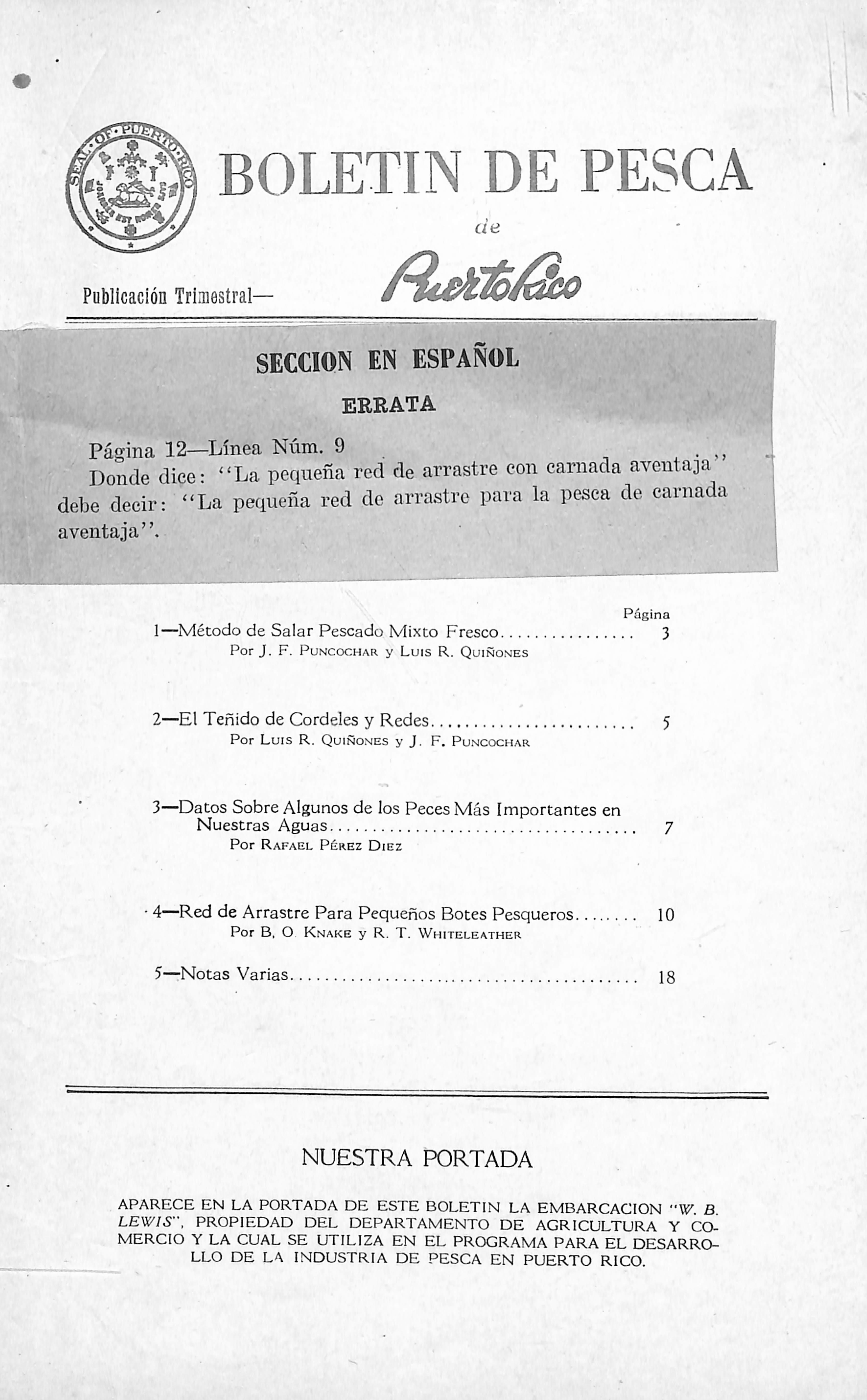
Publicación Trimestral-
Página 12—Línea Núm. 9 , Donde dice- "La pequeña red de arrastre con carnada aventaba debe decir: "La pequeña red de arrastro para la pesca de carnada aventaja".
I—Método de Salar Pescado Mixto Fresco
Por J. F. PUNCOCHAR y Luis R. Quiñones
2—El Teñido de Cordeles y Redes
Por Luis R. Quiñones y J. F. Puncochar
3—Datos Sobre Algunos de ios Peces Más Importantes en Nuestras Aguas
Por Rafael Pérez Diez
■ 4—Red de Arrastre Para Pequeños Botes Pesqueros 10 Por B, O Knake y R. T. Whiteleather
5—-Notas Varias.
APARECE EN LA PORTADA DE ESTE BOLETIN LA EMBARCACION "W. B. LEWIS", PROPIEDAD DEL DEPARTAMENTO DE AGRICULTURA Y CO MERCIO Y LA CUAL SE UTILIZA EN EL PROGR.AMA PARA EL DESARRO LLO DE LA INDUSTRIA DE PESCA EN PUERTO RICO.
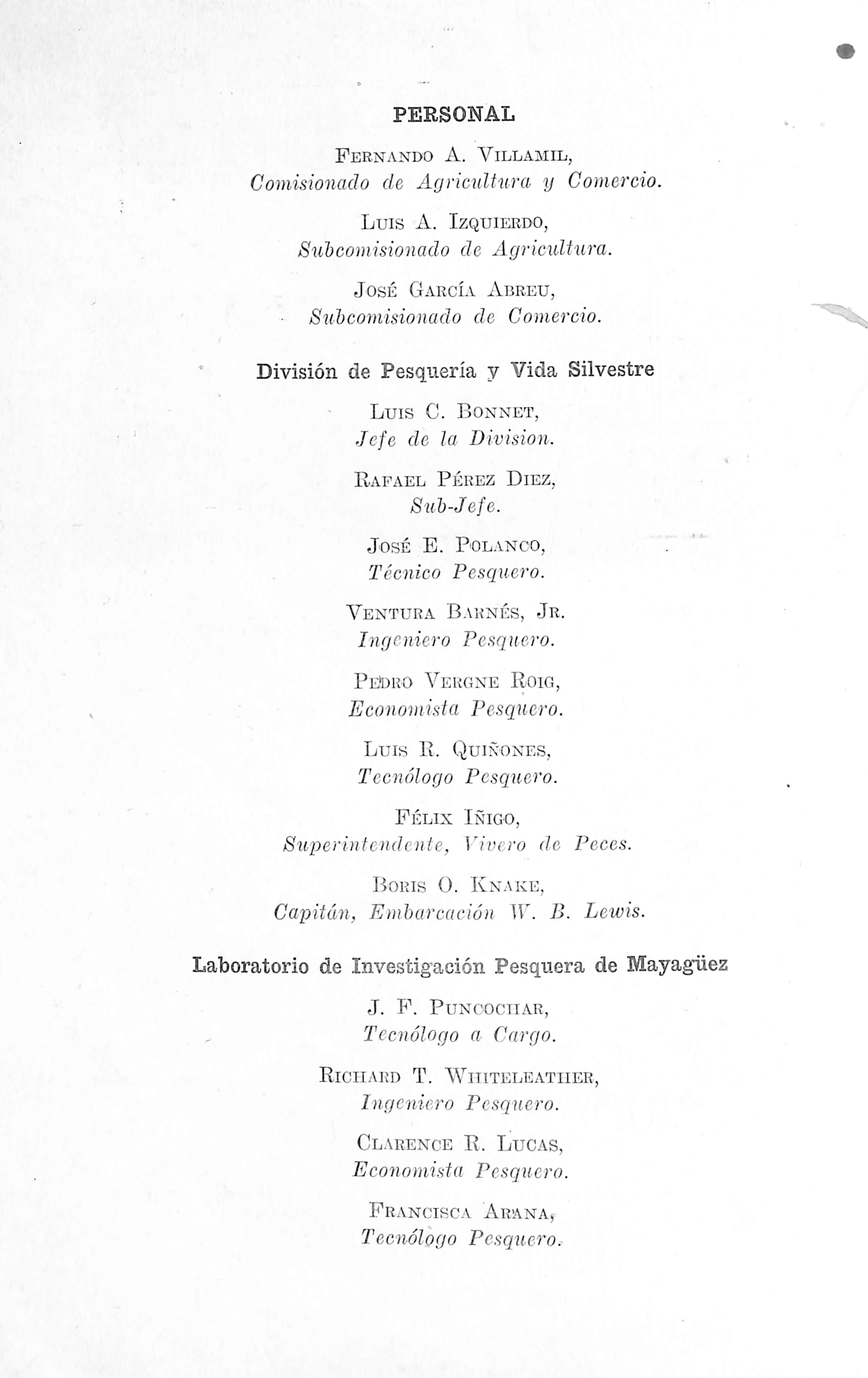
Fernando A. Villamid, Comisionado de Agricultura y Comercio.
Luis A. Izquierdo, Sul)comisionado de Agricultura.
José García Abreu, Suhcomisionado de Comercio.
División de Pesquería y Vida Silvestre
Luis C. Bonnet, Jefe de la División.
Kapael Pérez Diez, 8ul}-Jefe.
José E. Polanoo, J Técnico Pesquero.
Ventura Barnés, Jr. Ingeniero Pesquero.
PeDko Vekgne Roig, Economista Pesquero.
Luis E. Quiñones, Tecnólogo Pesquero.
Félix Iñigo, Superintendente, Vivero de Peces.
Boris o. Knake, Capitán, Embarcación IP. B. Lewis.
Laboratorio de Investigación Pesquera de Maya^ez
J. F. Puncoctiar, Tecnólogo a Cargo.
Richard T. Wiiiteleatiier, Ingeniero Pesquero.
Clarence R. Lucas, Economista Pesquero.
Francisca Arana, Tecnólogo Pesquero.-
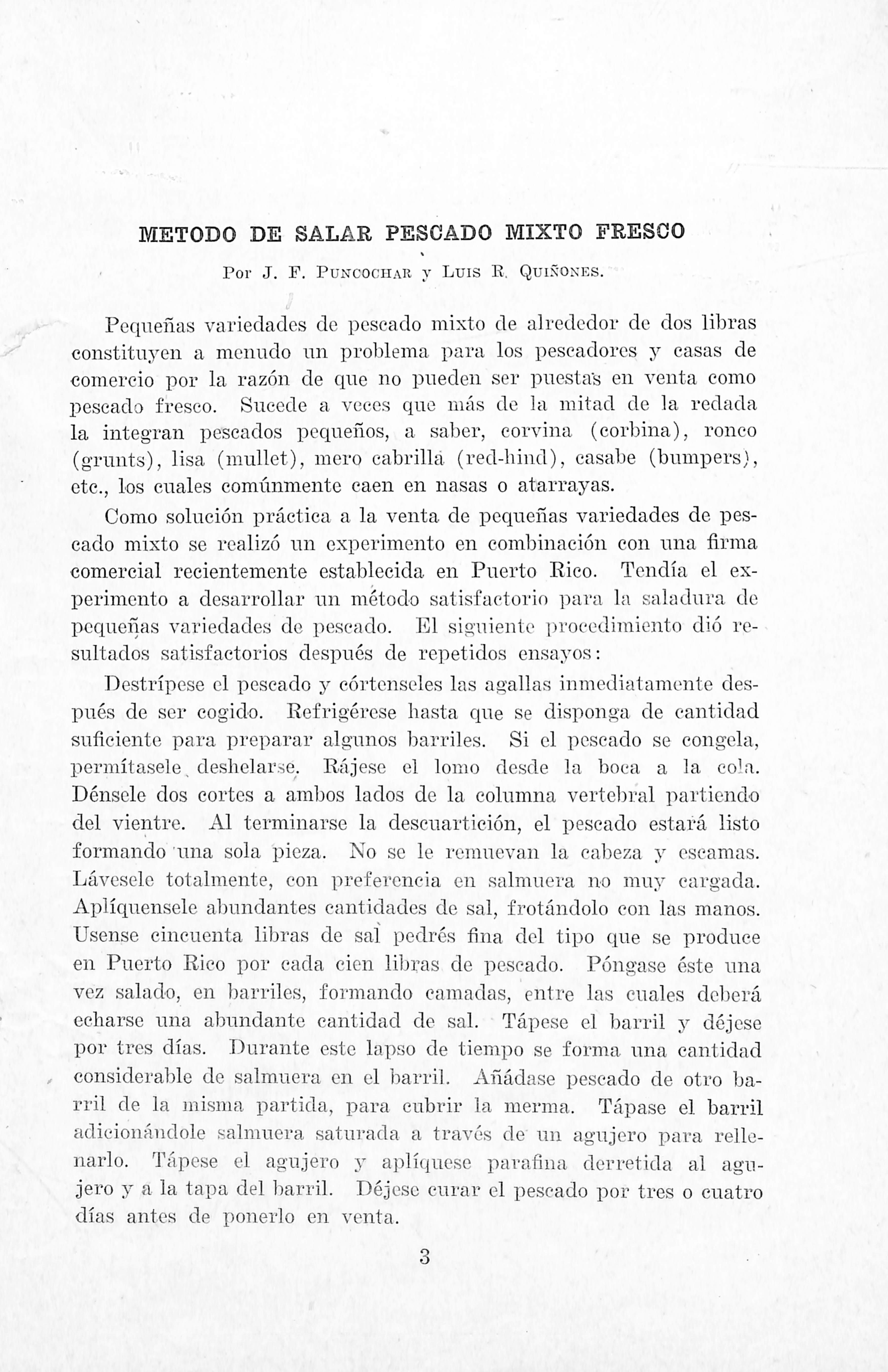
Por J. P. Puncochar y Luis E, Quiñones.
Pequeñas variedades de pescado mixto de alrededor de dos libras constituj'en a menudo un problema para los pescadores y casas de comercio por la razón de que no pueden ser puestas en venta como IDescado fresco. Sucede a veces que más de la mitad de la redada la integTan pescados pequeños, a saber, corvina (corbina), ronco (grunts), lisa (mullet), mero cabrilla (red-bind), casabe (bumpers), etc., los cuales comúnmente caen en nasas o atarrayas.
Como solución práctica a la venta de pequeñas variedades de pes cado mixto se realizó un experimento en combinación con una firma comercial recientemente establecida en Puerto Rico. Tendía el ex perimento a desarrollar un método satisfactorio para la saladura de pequeñas variedades de pescado. El siguiente procedimiento dió re sultados satisfactorios después de repetidos ensayos:
Destrípese el pescado y córtenseles las agallas inmediatamente des pués de ser cogido. Refrigérese hasta cpie se disponga de cantidad suficiente para preparar algunos barriles. Si el pescado se congela, permítasele, cleshelar.se. Rájese el lomo desde la boca a la cola. Dénsele dos cortes a ambos lados de la columna vertebral partiendo del vientre. Al terminarse la descuartición, el pescado estará listo formando una sola pieza. No se le remuevan la cabeza y escamas. Lávesele totalmente, con preferencia en salmuera no muj^ cargada. Aplíquensele abundantes cantidades de sal, frotándolo con las manos. Usense cincuenta libras de sal pedrés fina del tipo ciue se produce en Puerto Rico por cada cien libras de pescado. Póngase éste una vez salado, en barriles, formando camadas, entre las cuales dclierá echarse una abundante cantidad de sal. Tápese el barril y déjese por tres días. Durante este lapso de tiempo se forma una cantidad considerable de salmuera en el barril. Añádase pescado de otro ba rril de la misma partida, para cubrir la merma. Tápase el barril adicionándole salmuera saturada a través de un agujero para relle narlo. Tápese el agujero y apliqúese parafina derretida al agu jero y a la tapa del barril. Déjese curar el pescado por tres o cuatro días antes de ponerlo en venta.
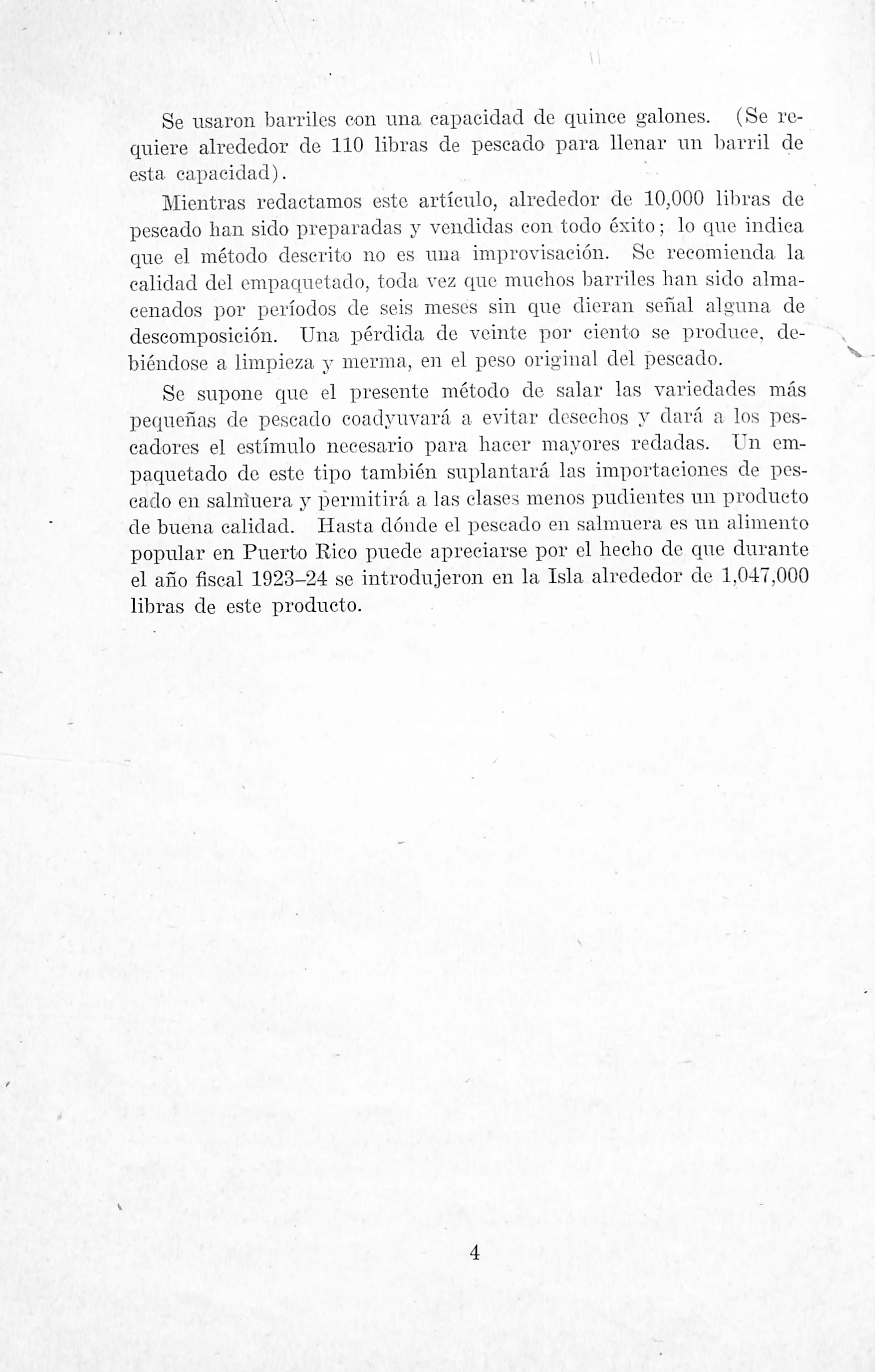
Se usaron barriles con una capacidad de quince galones. (Se re quiere alrededor de 110 libras de pescado para llenar un barril de esta capacidad).
Mientras redactamos esto artículo, alrededor de 10,000 libras de pescado han sido preparadas y vendidas con todo éxito; lo que indica que el método descrito no es una improvisación. Se recomienda la calidad del empaquetado, toda vez cpie muchos barriles han sido alma cenados por períodos de seis meses sin que dieran señal alguna de descomposición. Una pérdida de veinte por ciento se produce, de biéndose a limpieza y merma, en el peso original del pescado.
Se supone cinc el presente método de salar las variedades más pequeña.s de pescado coadyuvará a evitar desechos y clara a los pes cadores el estímulo necesario para hacer mayores redadas. Un em paquetado de este tipo también suplantará las importaciones de pes cado en salniuera y permitirá a las clases menos pudientes un producto de buena calidad. Hasta dónde el pescado en salmuera es un alimento popular en Puerto Rico puede apreciarse por el hecho de que durante el año fiscal 1923-24 se introdujeron en la Isla alrededor de 1,047,000 libras de este producto.
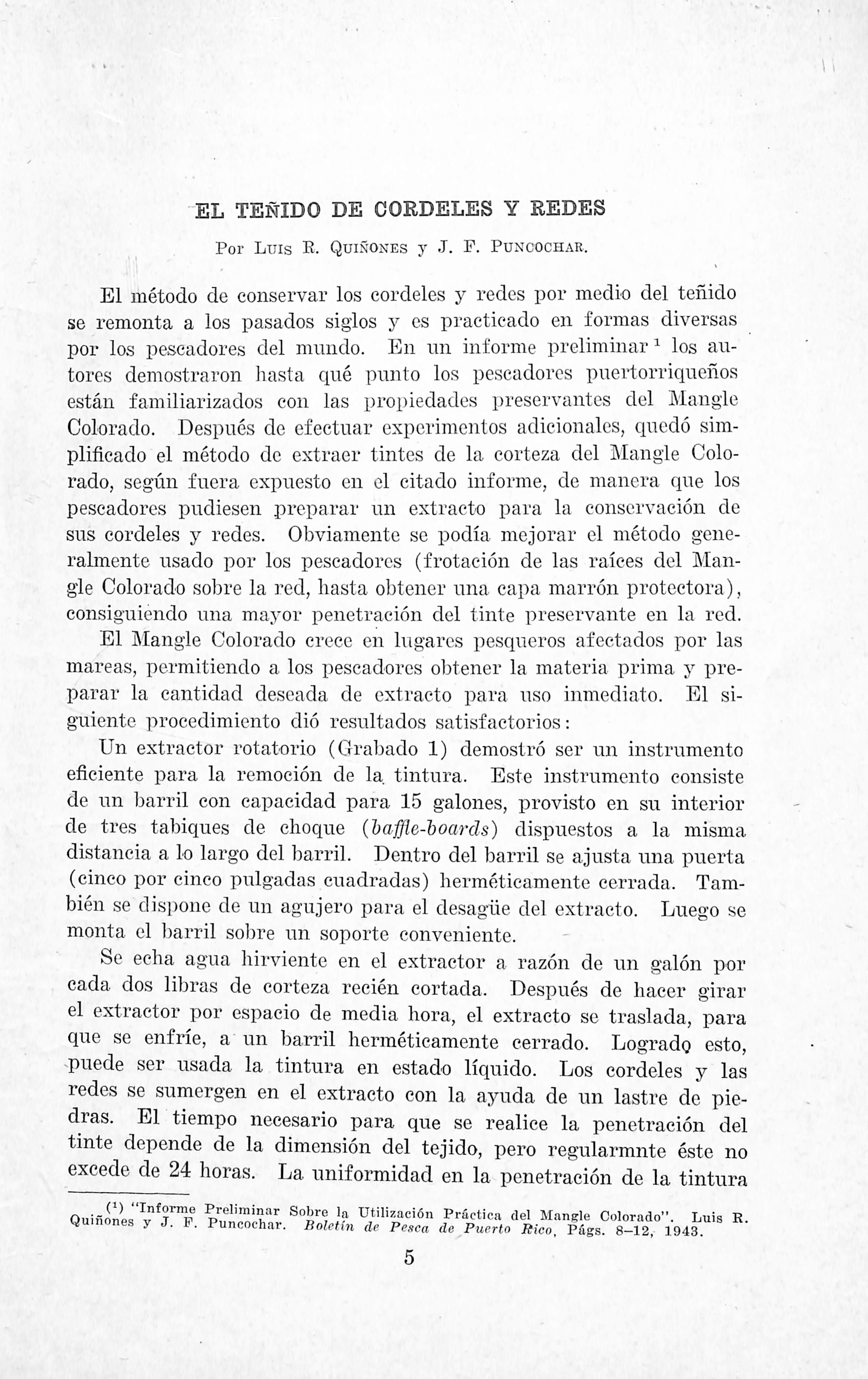
Por Luis E. Quiñones y J. F. Puncochar.
El método de conservar los cordeles y redes por medio del teñido se remonta a los pasados siglos y es practicado en formas diversas por los pescadores del mundo. En un informe preliminar ^ los au tores demostraron liasta qué punto los pescadores puertorriqueños están familiarizados con las propiedades preservantes del Mangle Colorado. Después de efectuar experimentos adicionales, quedó simpliñcado el método de extraer tintes de la corteza del Mangle Colo rado, según fuera expuesto en el citado informe, de manera que los pescadores pudiesen preparar un extracto para la conservación de sus cordeles y redes. Obviamente se podía mejorar el método gene ralmente usado por los pescadores (frotación de las raíces del Man gle Colorado sobre la red, hasta obtener una capa marrón protectora), consiguiendo una mayor penetración del tinte preservante en la red. El Mangle Colorado crece en lugares pesqueros afectados por las mareas, permitiendo a los pescadores obtener la materia prima y pre parar la cantidad deseada de extracto para uso inmediato. El si guiente procedimiento dió resultados satisfactoiños:
Un extractor rotatorio (Grabado 1) demostró ser un instrumento eficiente para la remoción de la. tintura. E.ste instrumento consiste de un barril con capacidad para 15 galones, provisto en su interior de tres tabiques de choque {haffle-hoards) dispuestos a la misma distancia a lo largo del barril. Dentro del barril se ajusta una puerta (cinco por cinco pulgadas cuadradas) herméticamente cerrada. Tam bién se dispone de un agujero para el desagüe del extracto. Luego se monta el barril sobre un soporte conveniente.
Se echa agua hirviente en el extractor a razón de un galón por cada dos libras de corteza recién cortada. Después de hacer girar el extractor por espacio de media hora, el extracto se traslada, para que se enfríe, a un barril herméticamente cerrado. Logrado esto, puede ser usada la tintura en estado liquido. Los cordeles y las redes se sumergen en el extracto con la ayuda de un lastre de pie dras. El tiempo necesario para que se realice la penetración del tinte depende de la dimensión del tejido, pero regularmnte éste no excede de 24 horas. La uniformidad en la penetración de la tintura
Quiñones"
Práctica del M.angle Colorado". Luis K. W y J. Jj. Puncochai. Boletín de Pesca de Puerto Jíico, Págs. 8—12, 1943.
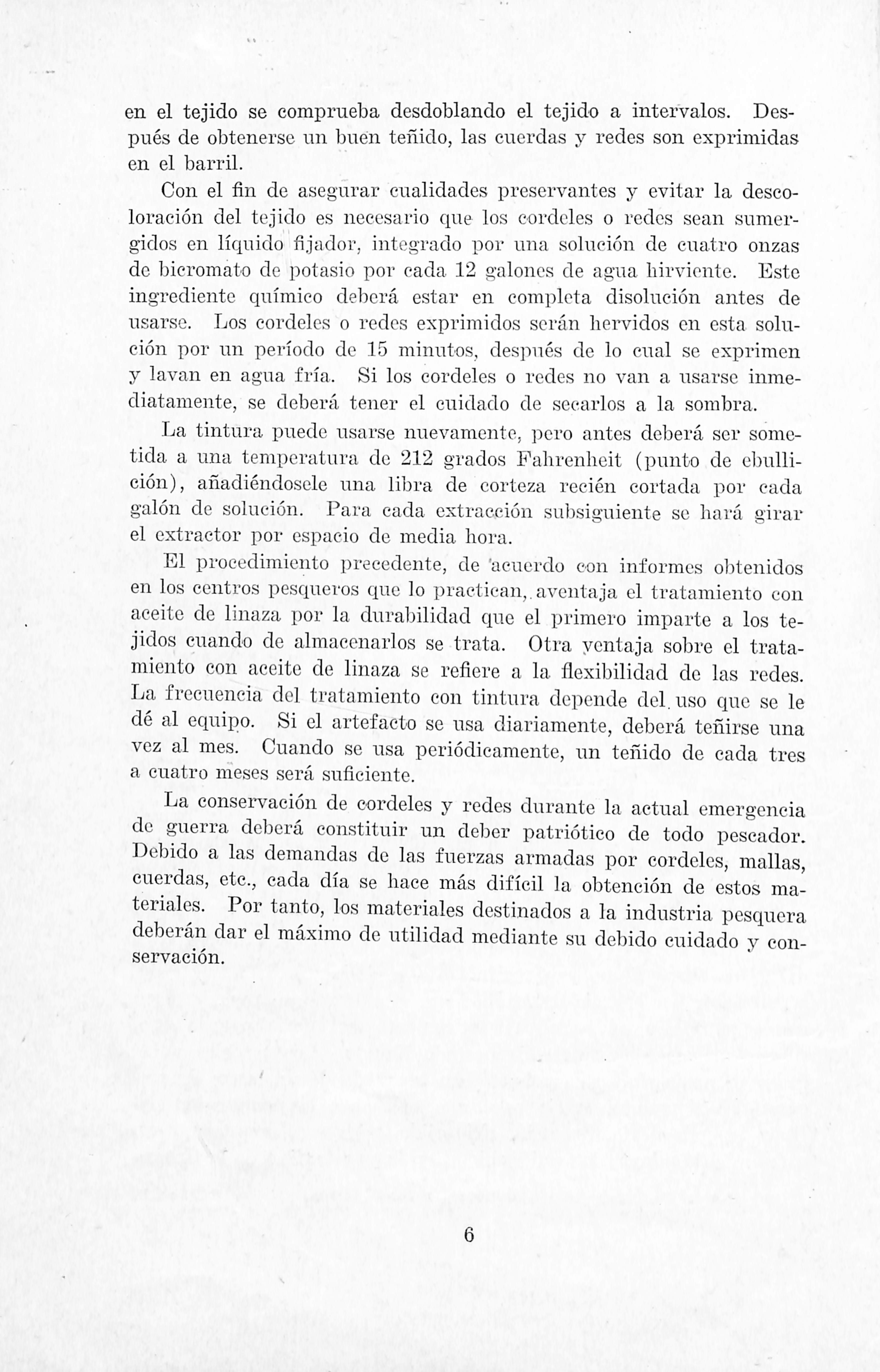
en el tejido se comprueba desdoblando el tejido a intervalos. Des pués de obtenerse un buen teñido, las cuerdas y redes son exprimidas en el barril.
Con el fin de asegurar cualidades preservantes y evitar la desco loración del tejido es necesario que los cordeles o redes sean sumer gidos en líquido fijador, integrado por una solución de cuatro onzas de bicromato de potasio por cada 12 galones de agua birviente. Este ingrediente químico deberá estar en completa disolución antes de usarse. Los cordeles o redes exprimidos serán heiuridos en esta solu ción por un período de 15 minutos, después de lo ci;al se exprimen y lavan en agua fría. Si los cordeles o redes no van a usarse inme diatamente, se deberá tener el cuidado de secarlos a la sombra.
La tintura puede usarse nuevamente, pero antes deberá ser some tida a una temperatura do 212 grados Fahrenheit (punto de ebulli ción), añadiéndosele una libra de corteza recién cortada por cada galón de solución. Para cada extracción subsiguiente se hará girar el extractor por espacio de media hora.
El procedimiento precedente, de 'acuerdo con informes obtenidos en los centros pesqueros ciuc io practican,,aventaja el tratamiento con aceite de linaza por la durabilidad que el primero imparte a los te jidos cuando de almacenarlos se trata. Otra ycntaja sobre el trata miento con aceite de linaza se refiere a la flexibilidad de las redes. La frecuencia del tratamiento con tintura depende del,uso que se le dé al equipo. Si el artefacto se usa diariamente, deberá teñirse una vez al mes. Cuando se usa periódicamente, un teñido de cada tres a cuatro meses será suficiente.
La conservación de cordeles y redes durante la actual emergencia de guerra deberá constituir un deber patriótico de todo pescador. Debido a las demandas de las fuei'zas armadas por cordeles, mallas, cueidas, etc., cada día se hace más difícil la obtención de estos ma teriales. Por tanto, los materiales destinados a la industria pesquera deberán dar el máximo de utilidad mediante su debido cuidado y con servación.

Por Rafael Pérez Diez.
Empezando con este número de nuestro "Boletín de Pesca" he mos creído necesario para beneficio de todos los amantes de la pesca en Puerto Rico y demás islas adj'acentes, hacer a manera de descrip ción e información un pequeño estudio de los peces más comunes y de importancia económica que habitan en las aguas del área del Caribe.
En diferentes visitas que hemos hecho a todos los centros de pesca en Puerto Rico nos encontramos con que existen criterios diferentes en cuanto a la identificación de peces y a la valoración de las cuali dades alimenticias de una y otra especie.
Hemos encontrado centros de pesca en los cuales los compra dores que se dedican a este negocio ya sea por ignorancia de su parte en la clasificación, o por deseos de propio beneficio, valúan la pesca únicamente a tono con su capricho.' A veces son ellos los perjudi cados, y otras el pescador que se ve olfiigado a venderle el producto de su trabajo.
Tenemos por ejemplo que en la familia de los pargos se incluyen diferentes especies. Todas estas con más o menos igual sabor y valor alimenticio, diferenciándose únicamente por su coloración, ta maño y otras particularidades de menos importancia.
Los mismos pescadores creen, por el hecho de existir las diferen cias arriba anotadas en una misma clase de peces, que éstos son dis tintos en todos los conceptos. De esta manera les es imposible agru parlos por clases y mucho menos por especies que les faciliten su identificación y valoración.
Todo pescador, o amante de la pesca, deportista, negociante o consumidor debería^ por lo menos tener una idea clara de la clase de peces que más abunda en los mares que nos rodean.
El beneficio que el pescador derivaría de su pesca, sería más no torio, conociendo ya de antemano el valor de las diferentes especies.
^ Aquél que se dedica a la pesca por deporte siente una atracción más cuando de identificar a un pez se trata. Crece su entusiasmo cuando reconoce que ha pescado una especie rara y muy preciada.
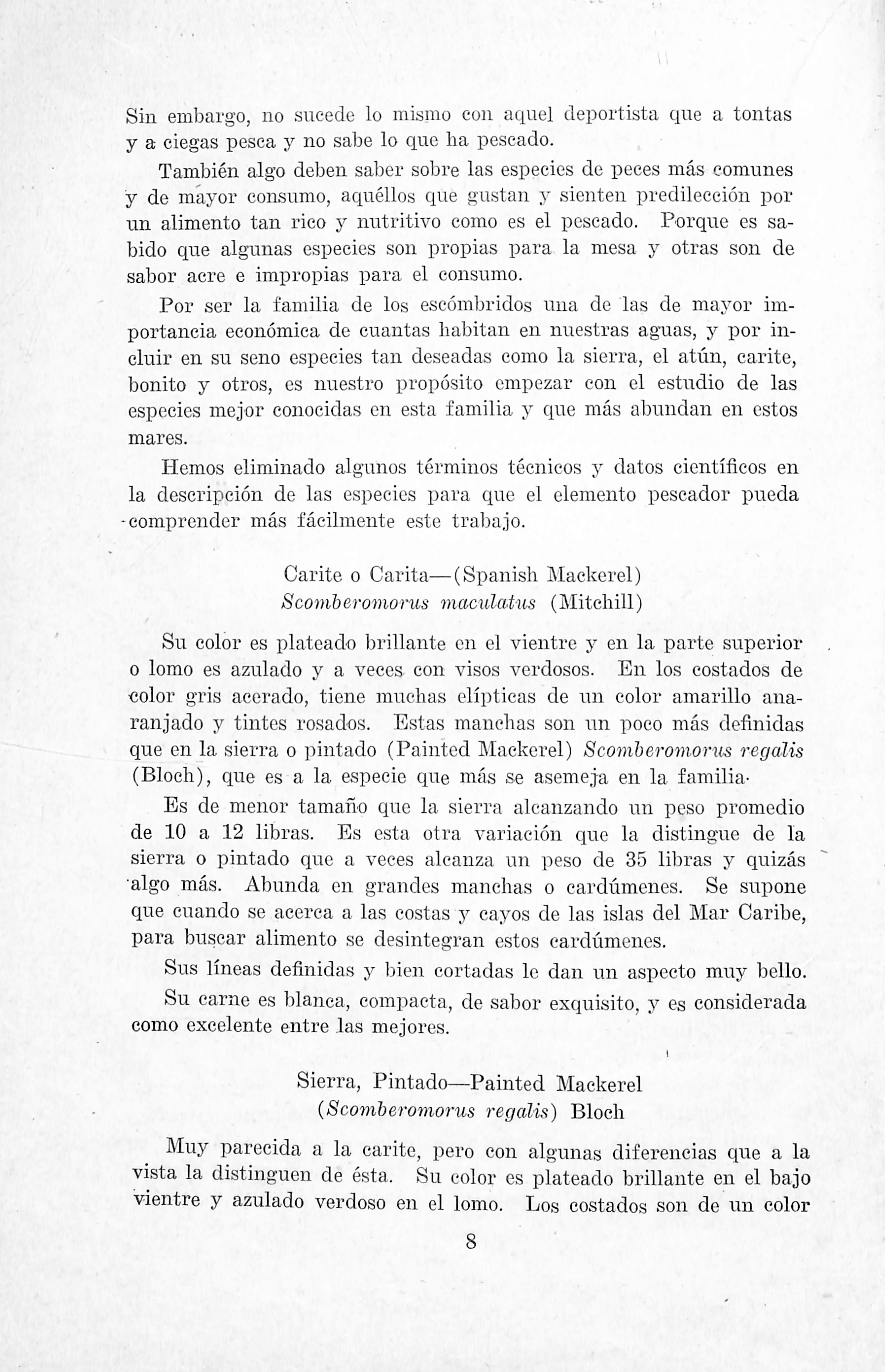
Sin embargo, no sucede lo mismo con aquel deportista que a tontas y a ciegas pesca y no sabe lo que ha pescado.
También algo deben saber sobre las especies de peces más comunes y de mayor consumo, aquéllos que gustan y sienten predilección por un alimento tan rico y nutritivo como es el pescado. Porque es sa bido que algunas especies son propias para la mesa y otras son de sabor acre e impropias para el consumo.
Por ser la familia de los escómbridos una de las de mayor im portancia económica de cuantas habitan en nuestras aguas, y por in cluir en su seno especies tan deseadas como la sierra, el atún, carite, bonito y otros, es nuestro propósito empezar con el estudio de las especies mejor conocidas en esta familia y que más abundan en estos mares.
Hemos eliminado algunos términos técnicos y datos científicos en la descripción de las especies para que el elemento pescador pueda -comprender más fácilmente este trabajo.
Carite o Carita—(Spanish Mackerel)
Scomberomorus maculatus (Mitchill)
Su color es plateado brillante en el vientre y en la parte superior o lomo es azulado y a veces con visos verdosos. En los costados de color gris acerado, tiene muchas elípticas de un color amarillo ana ranjado y tintes rosados. Estas manchas son un poco más definidas que en la sierra o pintado (Painted Mackerel) Scomberomonis regalis (Bloch), que es a la especie que más se asemeja en la familiaEs de menor tamaño que la sierra alcanzando un peso promedio de 10 a 12 libras. Es esta otra variación que la distingue de la sierra o pintado que a veces alcanza un peso de 35 libras y quizás algo más. Abunda en grandes manchas o cardúmenes. Se supone que cuando se acerca a las costas y cayos de las islas del Mar Caribe, para buscar alimento se desintegran estos cardúmenes.
Sus líneas definidas y bien cortadas le dan un aspecto muy bello. Su carne es blanca, compacta, de sabor exquisito, y es considerada como excelente entre las mejores.
Sierra, Pintado—Painted Mackerel {Scomheroinorus regalis) Bloch
Muy parecida a la carite, pero con algunas diferencias que a la vista la distinguen de ésta. Su color es plateado brillante en el bajo vientre y azulado verdoso en el lomo. Los costados son de un color

gris plateado, con manchas elípticas de nn color amarillo anaranjado con tintes rosa pálido. Estas manchas en líneas rectas son menos pronunciadas que en la carite.
No abunda tanto como la carite y tiene los mismos hábitos de migración, alimentación y desove.
Su apariencia también es muy bonita por el corte perfecto de sus líneas.
Su carne no es tan estimada como la de la carite y a veces es pastosa y de sabor poco agradable.
Cero-Cavalla-Sierra—(King-fish)
Scomierornorus ca valla Cuvier
El aspecto general de esta especie es muy parecido al de la carite y la sierra, pero si los comparamos hemos de notar que el color de ésta es plateado brillante en la mayor parte de su cuerpo. Su lomo o dorso es gris acerado y verdoso. En los especímenes más .jóvenes pue den notarse las manchas amarillo-anaranjadas características de las 'carites y las sierras, pero cuando son adultos no aparecen estas man chas elípticas y sí un ligero tinte rosado. Su cuerpo es menos com pacto que el de la siei'ra y por esto podemos reconocerlo y diferen ciarlo.
La aleta dorsal blanda no está en posición perpendicular a la aleta anal como en las carites. Está situada un poco más hacia adelante y esto sirve muy bien para distinguirlos.
Los hábitos de desove, alimentación y migración son idénticos a los de las otras especies do la familia de los escómbridos. Los car dúmenes siempre son de peces del mismo tamaño y esto también los diferencia de otras especies en la familia.
Su peso es superior al de ambas especies arriba mencionadas y se han llegado a pescar especímenes mayores de 5 pies y pesando más de 80 libras. Comúnmente se pescan con peso de 30 a 40 libras.
No abunda mucho en nuestras aguas. Su carne es blanca, com pacta, de buen sabor y muy preciada, pero no es tan buena y deseada como la de la carite o "Spanish Mackerel".
Albacora, Vaca, (Prigate Mackerel)
Auxis thazard (Lacepede)
Esta especie puede distinguirse fácilmente de las otras que perte necen a la misma familia, ya que su cuerpo es rollizo, robusto y más carnoso. Su dorso es color azul purpúreo muy intenso, casi negro, con rayas oblicuas de un color más obscuro en el fondo. La parte
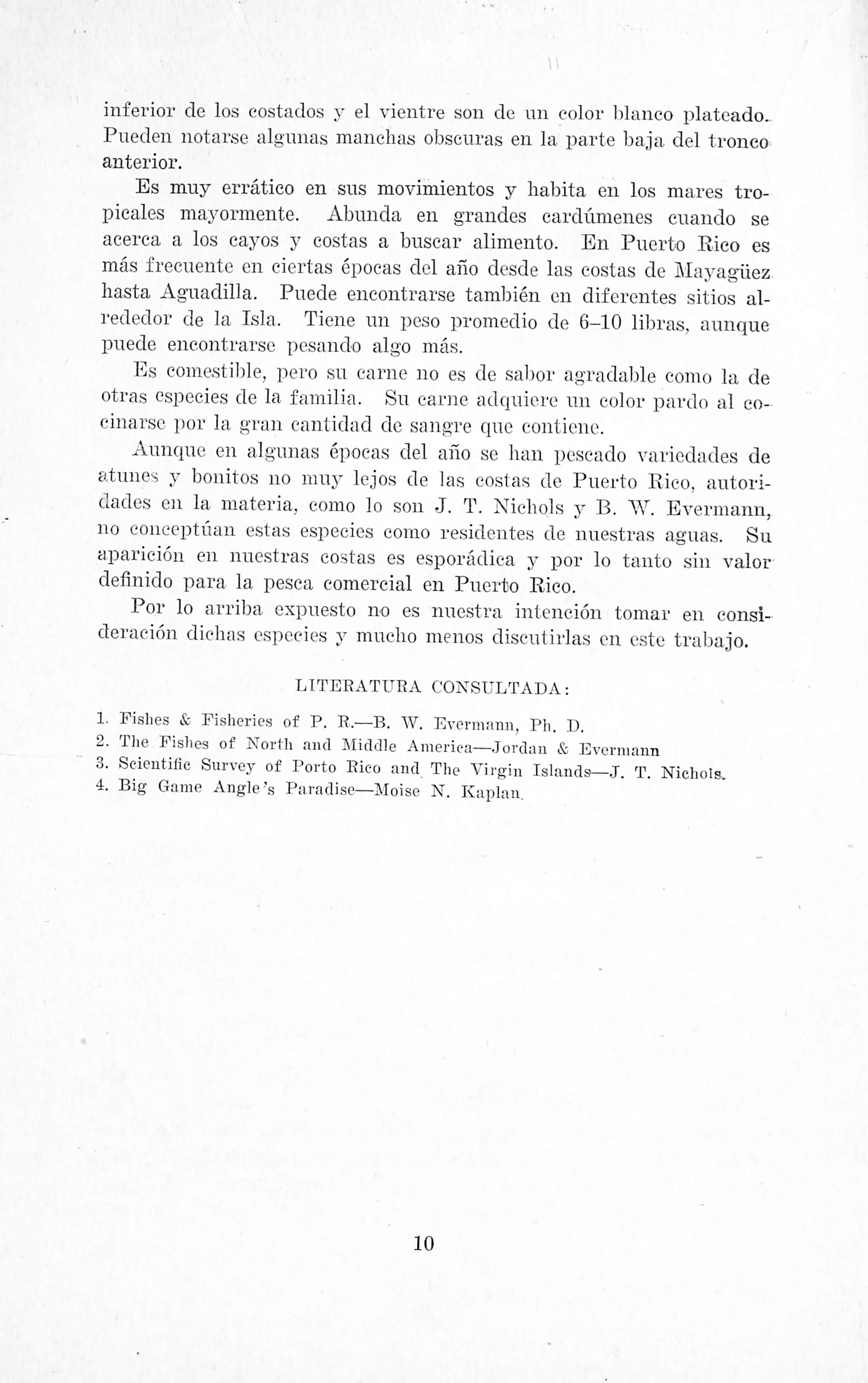
inferior de los costados y el vientre son de un color blanco plateado. Pueden notarse algunas manchas obscuras en la parte baja del tronco anterior.
Es muy errático en sus movimientos y habita en los mares tro picales mayormente. Abunda en grandes cardúmenes cuando se acerca a los cayos y costas a buscar alimento. En Puerto Rico es más frecuente en ciertas épocas del año desde las costas de Majmgüez hasta Aguadilla. Puede encontrarse también en diferentes sitios al rededor de la Isla. Tiene un peso promedio de 6-10 libras, aunque puede encontrarse pesando algo más.
Es comestible, pero su carne no es de sabor agradable como la de otras especies de la familia. Su carne adquiere un color pardo al co cinarse por la gran cantidad de sangre que contiene.
Aunque en algunas épocas del año se han pescado variedades de atunes y bonitos no muj* lejos de las costas de Puerto Rico, autori dades en la materia, como lo son J. T. Nichols y B. W. Evermann, no conceptúan estas especies como residentes de nuestras aguas. Su aparición en nuestx-as costas es esporádica y por lo tanto sin valor definido para la pesca comercial en Puerto Rico.
Por lo arriba expuesto no es nuestra intención tomar en consi deración dichas especies y mucho menos discutirlas en este trabajo.
1. Pishes & Pisherios of P. R.—B. W. Evermíimi, Ph. D.
2. The Pishes of North aiul Micldle América—.Jorclan & Evermann
3. Seientific Survey of Porto Rico and The Virgin Island^J. T. Nichols.
4. Big Game Angla's Paradise—Moise N. Kaplan,

Por B. O. Knake y E. T. Whiteleathek.
Con el nombre de red de arrastre (otter trawl) se conoce aquel tipo de cliincliorro de fondo empalmado con la parte posteiior del bote pesquero, según ilustra el grabadod La boca de la led se man tiene abierta por la acción de dos puertas de madera (trawl-boards) de tal modo adheridas a la red que, al tirarse de éstas a través del agua, se produce una reacción semejante a la de un cometa en el aire. Grandes redes de arrastre, movidas por botes equipados con propulsión Diesel, han sido uno de los mecanismos de primaria im portancia usados para coger enormes cantidades de peces en los bancos de Nueva Inglaterra, el Mar del Norte y otros puntos del globo. Estas grandes redes son de trazado difícil y representan el fruto de muchos años de experiencia y cambios constantes. Las embarcaciones que las usan disponen de tornos especiales y equipo especíñcamcnte diseñado para la operación de arrastre. Teniendo en mente que el bote pesquero regular usado en Puerto Rico no es lo suficientemente grande ni está debidamente equipado para hacer fun cionar una red de alcance comercial, durante el riltimo año se han hecho experimentos a los fines de diseñar y adaptar una pequeña red de arrastre a los botes de vela y embarcaciones comunes en las zonas pesqueras de Puerto Rico.
Un tipo de nasa (box net) con tejido de algodón es proljablementc uno de los artefactos más sencillos de redes de arrastre a construii-se debido a que en ésta se utilizan los fundamentos básicos de la más grandes y complicadas barrederas. Algunas de las páginas subsi guientes se dedicarán a pormenorizar la construcción del tipo de nasa con puertas de madera a ser usada con pequeños botes de vela y em barcaciones corrientes. Por supuesto, antes de explicar en detalle Iñ construcción de este artefacto, parece de rigor puntualizar las ven tajas y limitaciones de usar un aparato de esta índole en las aguas adyacentes a las costas de Puerto Rico. Estos son problemas qi;e ha brá de plantearse cualquier pescador ajeno al funcionamiento de este tipo de mecanismo al evaluar su importancia comercial.
BuIletiX^'of'^ Trawl Net for Sinall Pishing Boats". púgin.-i 12, "Fisliery
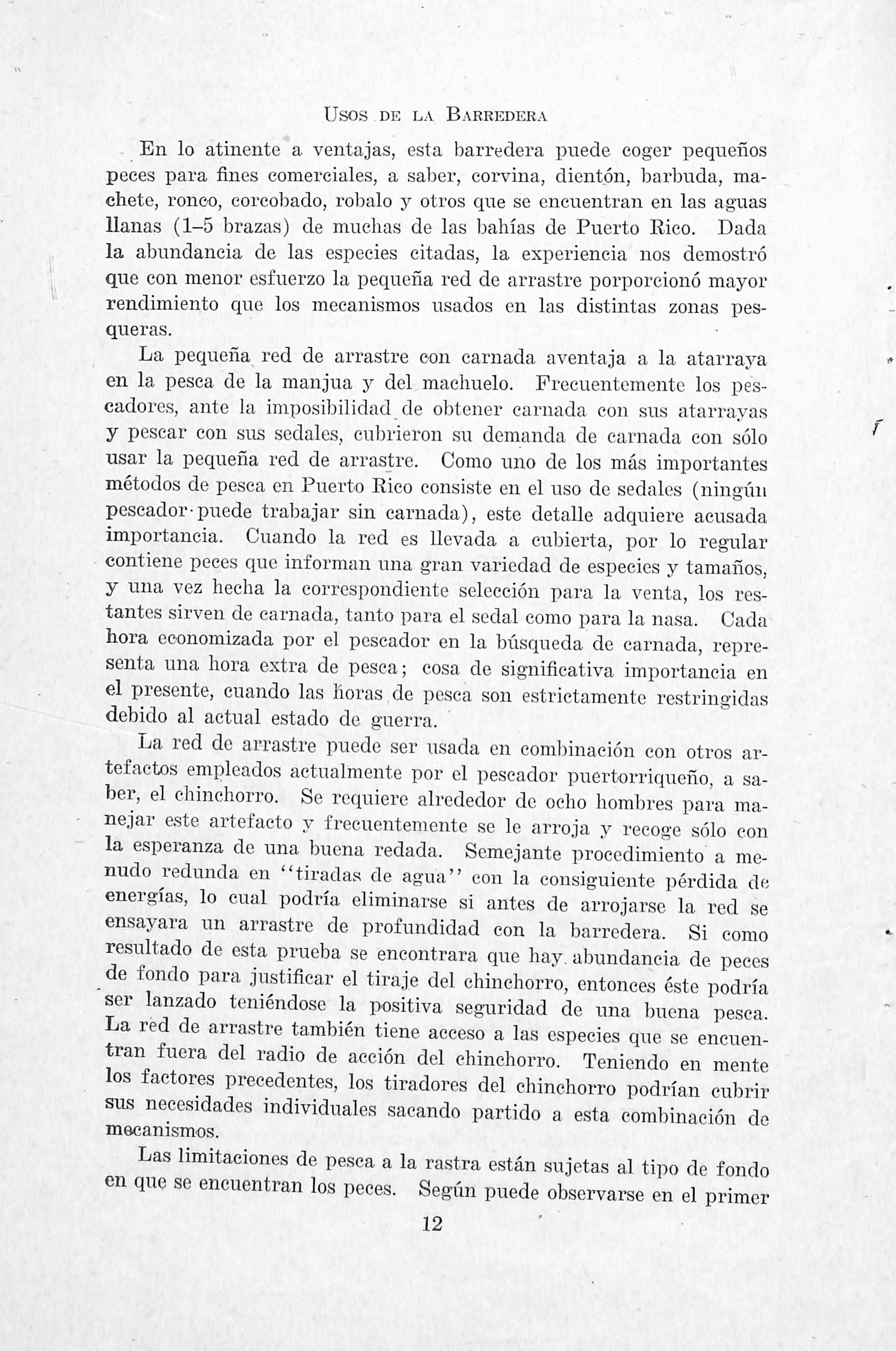
Usos DE LA Barredera
En lo atinente a ventajas, esta barredera puede coger pequeños peces para fines comei'ciales, a saber, corvina, dientón, barbuda, ma chete, ronco, corcobado, robalo y otros que se encuentran en las aguas llanas (1-5 brazas) de muchas de las bahías de Puerto Rico. Dada la abundancia de las especies citadas, la experiencia nos demostró que con menor esfuerzo la pequeña red de arrastre porporcionó mayor rendimiento que los mecanismos usados en las distintas zonas pes queras.
La pequeña red de arrastre con carnada aventaja a la atarraya en la pesca de la manjúa y del machuelo. Frecuentemente los pes cadores, ante la imposibilidad de obtener carnada con sus atarrayas y pescar con sus sedales, cubrieron su demanda de carnada con sólo usar la pequeña red de arrastre. Como uno de los más importantes métodos de pesca en Puerto Rico consiste en el uso de sedales (ningún pescador-puede trabajar sin carnada), este detalle adquiere acusada importancia. Cuando la red es llevada a cubierta, por lo regular contiene peces que informan una gran variedad de especies y tamaños, y una vez hecha la correspondiente selección para la venta, los res tantes sirven de carnada, tanto para el sedal como para la nasa. Cada hora economizada por el pescador en la búsqueda de carnada, repre senta una hora extra de pesca; cosa de significativa importancia en el piesente, cuando las horas de pesca son estrictamente restringidas debido al actual estado de guerra.
La red de arrastre puede ser usada en comljinación con otros ar tefactos empleados actualmente por el pescador puertorriqueño, a sa ber, el chinchorro. Se requiere alrededor de ocho hombres para ma nejar e.ste artefacto y frecuentemente se le arroja y recoge sólo con la esperanza de una buena redada. Semejante procedimiento a me nudo ledunda en "tiradas de agua" con la consiguiente pérdida de energías, lo cual podría eliminarse si antes de arrojarse la red se ensayara un arrastre de profundidad con la barredera. Si como resiütado de esta prueba se encontrara que hay.abundancia de peces e ondo para justificar el tiraje del chinchorro, entonces éste podría ser lanzado teniéndose la positiva seguridad de una buena pesca. La red de arrastre también tiene acceso a las especies que se encuen tran fuera del radio de acción del chinchorro. Teniendo en mente ios factores precedentes, los tiradores del chinchorro podrían cubrir sus necesidades individuales sacando partido a esta combinación de mecanismos.
Las limitaciones de pesca a la rastra están sujetas al tipo de fondo en que se encuentran los peces. Según puede observarse en el primer

grabado, este artefacto es arrastrado estando todos sus accesorios en contacto con el fondo. Por consiguiente, el fondo debe estar razona blemente libre de arrecifes coralinos, rocas, áncoras viejas, eseomJiros de madera y otros obstáculos. Generalmente las áreas propicias a la pesca con cliincorro son adaptaliles a este tipo de aiiastie. En muchas de las bahías, donde los ríos desembocan en el océano, el sedimento forma peciueños deltas. En estos lugares también hay áreas propicias al uso de una pequeña barredera. Algunas localidades, entre las que figuran la Bahía de Añasco, la Bahía de Tallaboa, el Puerto de Jobos, la Bahía de Puerto Real, la Bahía de Guayanilla y la Bahía del Río Grande de Loíza han sido sometidas a la prueba de la red de arrastre con resultados altamente satisfactorios. La pesca fluctuó considerablemente durante el experimento realizado, pero en las bahías de Añasco y Puerto Real se hizo una pesca máxima de aproximadamente noventa y cinco (95) libras por hora de arras tre. Con frecuencia se pescó mucho menos, por lo que sería aven turado el hablar en términos precisos solu'e el rendimiento de este aparato. Cualquier pescador interesado en probar una nueva red de éstas tendría cpre llegar a sus propias conclusiones, aumentando su pesca en la proporción en que ganase experiencia. Es lamentable que mucho del fondo de las aguas que rodean a Puerto Rico sea tan irregular y áspero que no permita la pesca a la rastra ilimitada; sin embargo, este mecanismo probaría su excelencia en las áreas donde pudiera ser usado.
La estación del año más propicia para la pesca fluctuará de acuerdo con las diferentes localidades costaneras, y a este respecto no se puede aplicar una regla invariablemente rigurosa. Datos debida mente comprobados por nosotros demuestran, en general, que en la estación de las lluvias abundan los peces y las redadas son mayores. Para este tiempo el agua de la bahía se torna un si es no es salobre debido a la gran cantidad de agua dulce proveniente de los ríos confluentes. Los peces aparecen en las bahías a la búsqueda de ali mentos arrastrados por los ríos crecidos. Este hecho no requiere ser muy acentuado, toda vez que los pescadores familiarizados con estas aguas saben cuándo hacen su,aparición las distintas especies de peces.
Construcción de la Red
(Véanse grabados en la sección de inglés)
A continuación insertamos algunos grabados detallando la cons trucción de la red de arrastre, la cual puede ser remolcada por un bote de vela corriente o por una de las embarcaciones operadas al
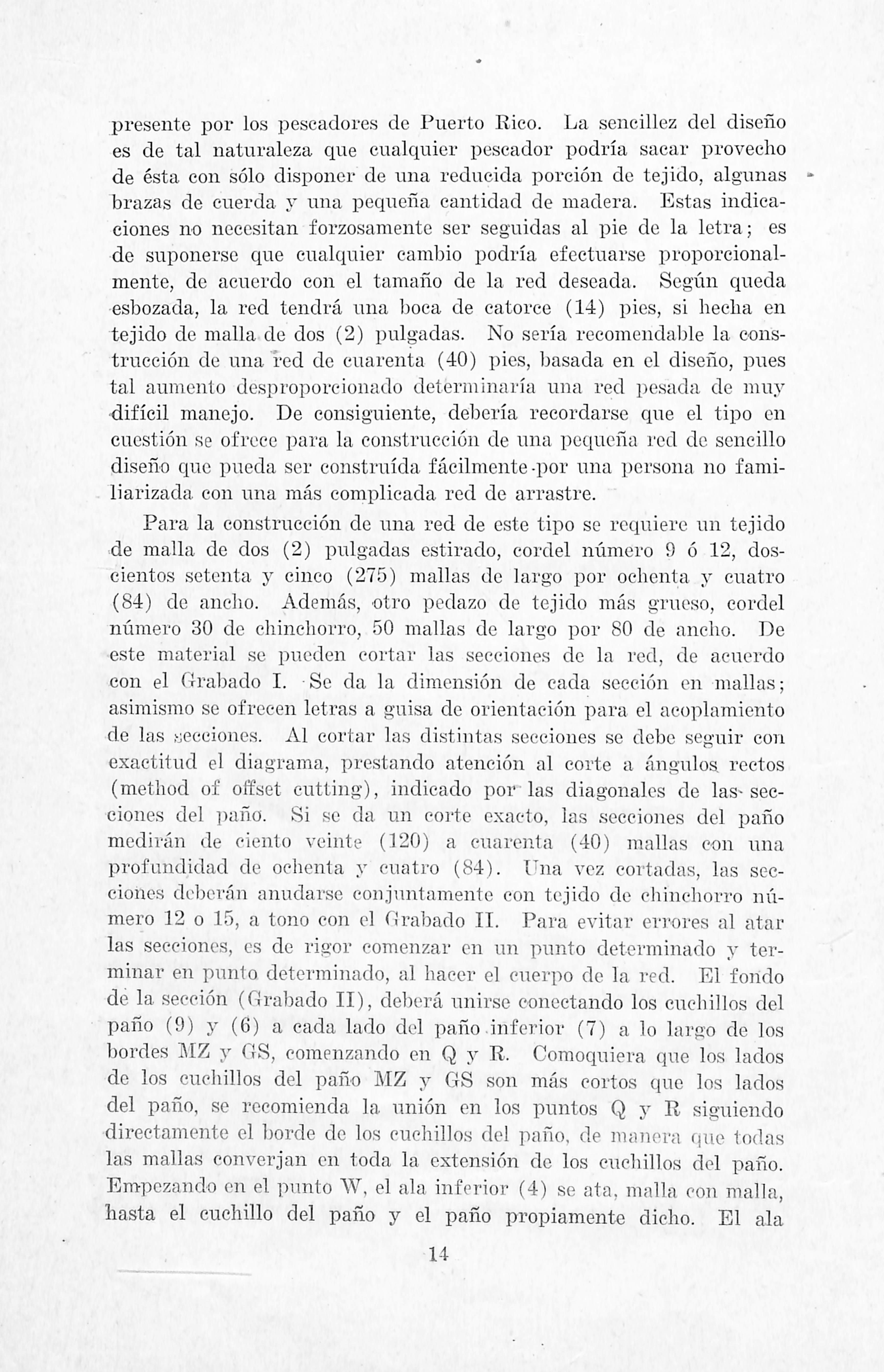
pi'esente poz- los pescadores de Puerto Rico. La sencillez del diseño es de tal naturaleza que cualquier pescador podría sacar provecho de ésta con sólo disponer de rzna reducida poi-ción de tejido, algunas hrazas de cuerda y una pequeña cantidad de madera. Estas indica ciones no necesitan forzosamente ser seguidas al pie de la letra; es de suponerse que cualquier cambio podría efectuarse proporcionalmente, de acuerdo con el tamaño de la red deseada. Según queda •esbozada, la red tendrá una boca de catorce (14) pies, si becba en tejido de malla de dos (2) pulgadas. No sería recomendable la cons trucción de una red de cuarenta (40) pies, basada en el diseño, ptzes tal aumento desproporcionado determinaría una red pesada de muy •difícil manejo. De consiguiente, debería recordarse que el tipo en cuestión se ofrece para la construcción de una pequeña red de sencillo diseño que pueda ser construida fácilmente-por una persona no fami liarizada con una más complicada red de arrastre.
Para la construcción de una red de este tipo se requiere un tejido de malla de dos (2) pulgadas estirado, cordel número 9 ó 12, dos cientos setenta y cinco (275) mallas de largo por oebenta y cuatro (84) de ancho. Además, otro pedazo de tejido más grueso, cordel número 30 de cbincborro, 50 mallas de largo por 80 de ancho. De este material se pizcden cortar las secciones de la red, de acuerdo con el Drabado I. Se da la dimensión de cada sección en mallas; asimismo se ofrecen letras a guisa de orientación para el acoplamiento de las secciones. Al cortar las distizitas secciones se debe seguir con exactitud el diagrama, prestando atención al corte a ángulos rectos (metbod of offset cutting), indicado por las diagonales de las» sec ciones del ])año. Si se da un corte exacto, las secciones del paño medirán de ciento veinte (120) a cuarenta (40) mallas con una profundidad de oebenta y cuatro (84). Ibia vez cortadas, las sec ciones deberán anudarse conjuntamente con tejido de cbincborro nú mero 12 o 15, a tono con el Grabado II. Para evitar errores al atar las secciones, es de rigor comenzar en un punto determinado y ter minar en punto determinado, al hacer el cuerpo de la red. El fondo de la sección (Grabado II), deberá unirse conectando los cuchillos del paño (9) y (6) a cada lado del paño inferior (7) a lo largo de los bordes MZ y GS, comenzando en Q y R. Comoquiera que los lados de los cuchillos del paño MZ y GS son más cortos que los lados del paño, se recomienda la unión en los puntos Q y R siguiendo directamente el borde do los cuchillos del paño, de manera que todas las mallas converjan en toda la extensión de los cuchillos del paño. Empezando en el punto W, el ala inferior (4) se ata, malla con malla, hasta el cuchillo del paño y el paño propiamente dicho. El ala
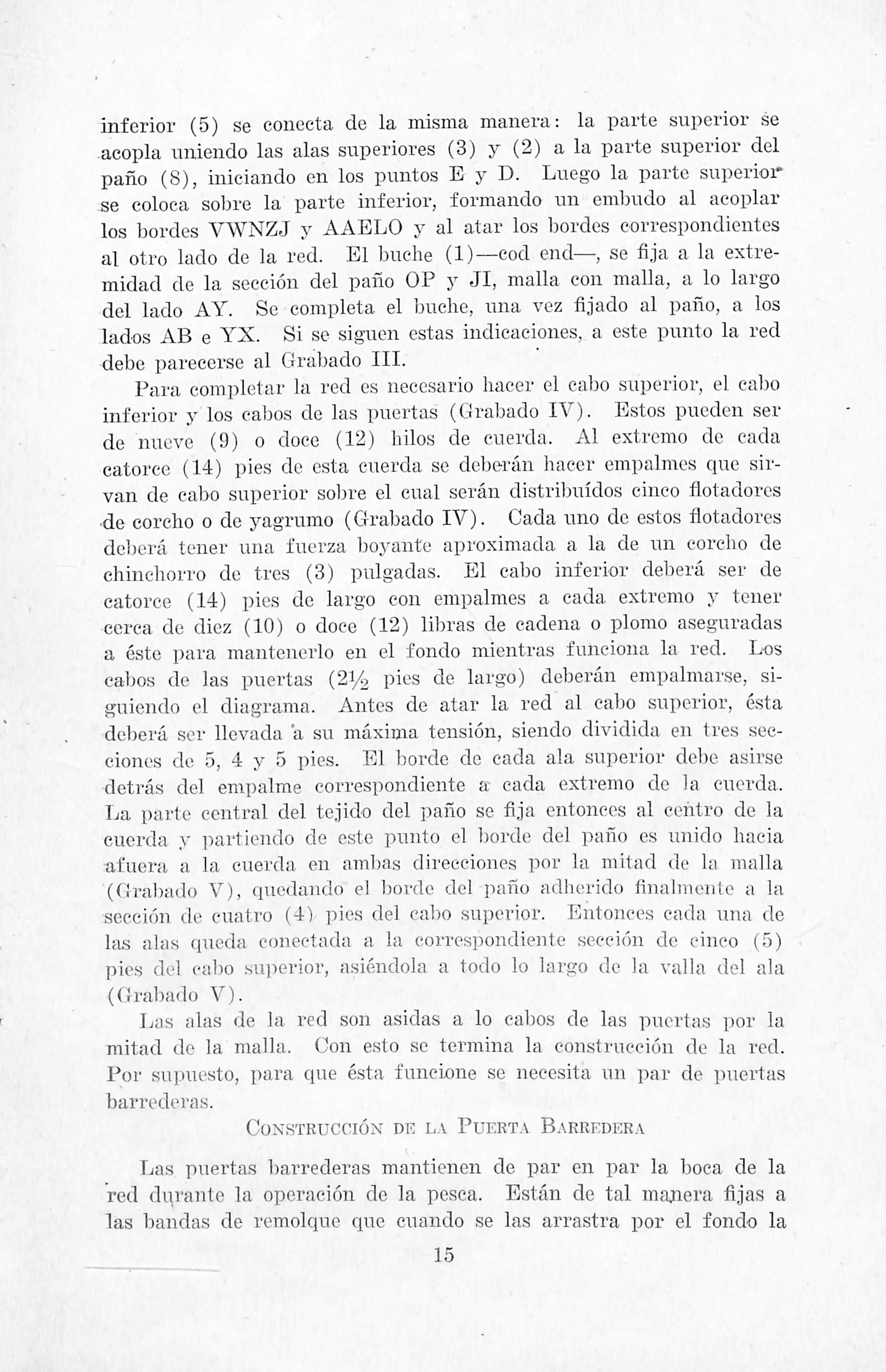
inferior (5) se conecta de la misma manera: la parte superior se acopla uniendo las alas superiores (3) y (2) a la parte superior del paño (8), iniciando en los puntos E y D. Luego la parte superior se coloca sobre la parte inferior, formando un embudo al acoplar los bordes VWNZJ y AAELO y al atar los bordes correspondientes al otro lado de la red. El buche (1)—eod end—, se fija a la extre midad de la sección del paño OP y JI, malla con malla, a lo largo del lado AY. Se completa el buche, una vez fijado al paño, a los lados AB e YX. Si se siguen estas indicaciones, a este punto la red debe parecerse al Grabado III.
Para completar la red es necesario hacer el cabo superior, el cabo inferior y los cabos de las puertas (Grabado IV). Estos pueden ser de nueve (9) o doce (12) hilos de cuerda. Al extremo de cada catorce (14) pies de esta cuerda se deberán hacer empalmes que sir van de cabo superior sobre el cual serán distribuidos cinco flotadores ■de corcho o de yagrumo (Grabado IV). Cada uno de estos flotadores deberá tener una fuerza boyante aproximada a la de un corcho de chinchorro de tres (3) pulgadas. El cabo inferior deberá ser de catorce (14) pies de largo con empalmes a cada extremo y tener cerca de diez (10) o doce (12) libras de cadena o plomo aseguradas a éste para mantenerlo en el fondo mientras funciona la red. Los cabos de las puertas (21/2 pies de largo) deberán empalmarse, si guiendo el diagrama. Antes de atar la red al cabo superior, ésta deberá ser llevada a su máxima tensión, siendo dividida en tres sec ciones de 5, 4 y 5 pies. El borde de cada ala superior debe asirse detrás del empalme correspondiente a cada extremo de la cuerda. La parte central del tejido del paño se fija entonces al centro de la cuerda y partiendo de este punto el borde del paño es unido hacia afuera a la cuerda en ambas direcciones por la mitad de la malla (Grabado V), quedando el bordo del paño adherido finalmente a la sección de cuatro (4) pies del cabo superior. Entonces cada una de la.s alas queda conectada a la correspondiente sección de cinco (5) pies del cabo sujierior, asiéndola a todo lo largo de la valla del ala (Grabado V).
Las alas de la red son asidas a lo cabos de las puertas por la mitad de la malla. Con esto se termina la construcción de la red. Por supuesto, para que ésta funcione se necesita un par de puertas barrederas.
Construcción de l.v Puert.\ Barreder.\
Las puertas barrederas mantienen de par en par la boca de la red durante la operación de la pesca. Están de tal majiera fijas a las bandas de remolque que cuando se las arrastra por el fondo la
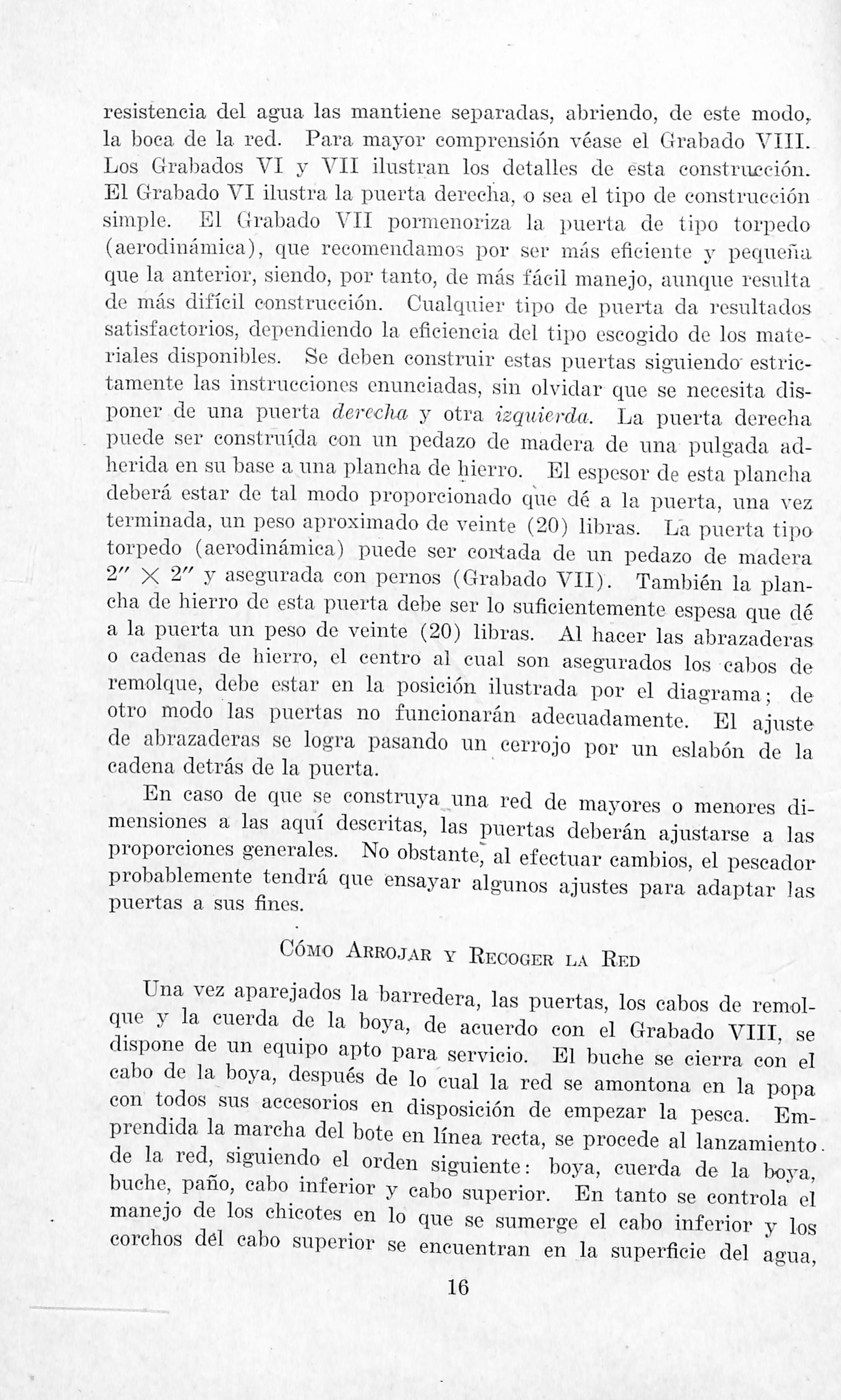
resistencia del agua las mantiene separadas, abriendo, de este modo, la boca de la red. Para mayor comprensión véase el Grabado VIII. Los Grabados VI y VII ilustran los detalles de ésta constricción. El Grabado VI ilustra la puerta derecha, o sea el tipo de construcción simple. El Grabado VII pormenoriza la i)uerta de tipo torpedo (aerodinámica), cjue recomendamos por ser más eficiente y pequeña que la anterior, siendo, por tanto, de más fácil manejo, aunque resulta de más difícil construcción. Cualquier tipo de puerta da resultados satisfactorios, dependiendo la eficiencia del tipo escogido de los mate riales disponibles. Se deben construir estas puertas siguiendo' estric tamente las instrucciones enunciadas, sin olvidar que se necesita dis pone! de una puerta derecha y otra izQuicrda. La puerta derecha puede ser construida con un pedazo de madera de una pulgada ad herida en su base a una plancha de hierro. El espesor de esta plancha debela estar de tal modo proporcionado que dé a la puerta, una vez terminada, un peso aproximado de veinte (20) libras. La puerta tipo torpedo (aerodinámica) puede ser cortada de un pedazo de madera 2" X 2" y asegurada con pernos (Grabado VII). También la plan cha de hierro de esta puerta debe ser lo suficientemente espesa que dé a la puerta un peso de veinte (20) libras. Al hacer las abrazaderas o cadenas de hierro, el centro al cual son asegmrados los callos de remolque, debe estar en la posición ilustrada por el diagrama; de otro modo las puertas no funcionarán adecuadamente.'^El ajuste de abrazaderas se logra pasando un cerrojo por un eslabón de la cadena detrás de la puerta.
En caso de que se construya una red de mayores o menores di mensiones a las aquí descritas, las puertas deberán ajustarse a las proporciones generales. No obstante; al efectuar cambios, el pescador probablemente tendrá que ensayar algunos ajustes para adaptar las puertas a sus fines.
Cómo Arrojar y Recoger la Red
Una vez aparejados la barredera, las puertas, los cabos de remol que y a cuerda de la boya, de acuerdo con el Grabado VIII, se dispone de un equipo apto para servicio. El buche se cierra con el cabo de la boya, después de lo cual la red se amontona en la popa con todos sus accesorios en disposición de empezar la pesca. Em prendida a marcha del bote en línea recta, se procede al lanzamiento, de a red^ siguiendo el orden siguiente; boya, cuerda de la Imya buche, paño cabo inferior y cabo superior. En tanto se controla eí manejo de los chicotes en lo que se sumerge el cabo inferior y los corchos del cabo superior se encuentran en la superficie del agua.

indicando que toda la red está debidamente esparcida. Se aflojan las bandas lentamente para mantener la fuerza expansiva de la red y en el acto se arrojan las puertas. Se controla la abrazadeia en lo que la marcha acelerada del bote separa las puertas. Cuando se logra el objetivo de separar las puertas convenientemente, y estas em piezan a hundirse, se hace funcionar la cuerda de remolque lenta mente hasta que la red toca fondo. La cuerda de remolque se ata a una bita, al mismo tiempo que se acelera el bote para hacer funcionar la red sobre el fondo.
Cuando se pesca en profundidades de alrededor de 1-5 brazas, como diez (10) brazas de cuerdas de remolque deberán mediar entre el bote y la abrazadera. (La abrazadera tiene diez (10) brazas de largo). Esto arroja un total de veinte brazas de cuerda entre el bote y las puertas. En aguas más profundas la cuerda de remolque de berá ser tres veces mayor que la profundidad del agua. Con el fin de no volcar las puertas en el fondo, cuando se precise efectuar un cambio en el rumbo directo del bote, se procederá gradualmente a tomar el rumbo deseado. La red deberá ser arrastrada por espacio de veinte minutos o más, si así se desea.
A la hora indicada de sacar la red, se tira de la cuerda de remol que con las manos o por medio de un torno. Dos hombres pueden tirar de las pequeñas redes de este tipo. Naturalmente, para tirar de una red mayor se necesitará disponer de un artefacto mecánico. Cuando el buche llega a cubierta se suelta la cuerda de la boya, permitiendo la abertura del cabo inferior del buche, lo que permite la salida de los peces. Así se facilita la operación de tirar la red nuevamente.
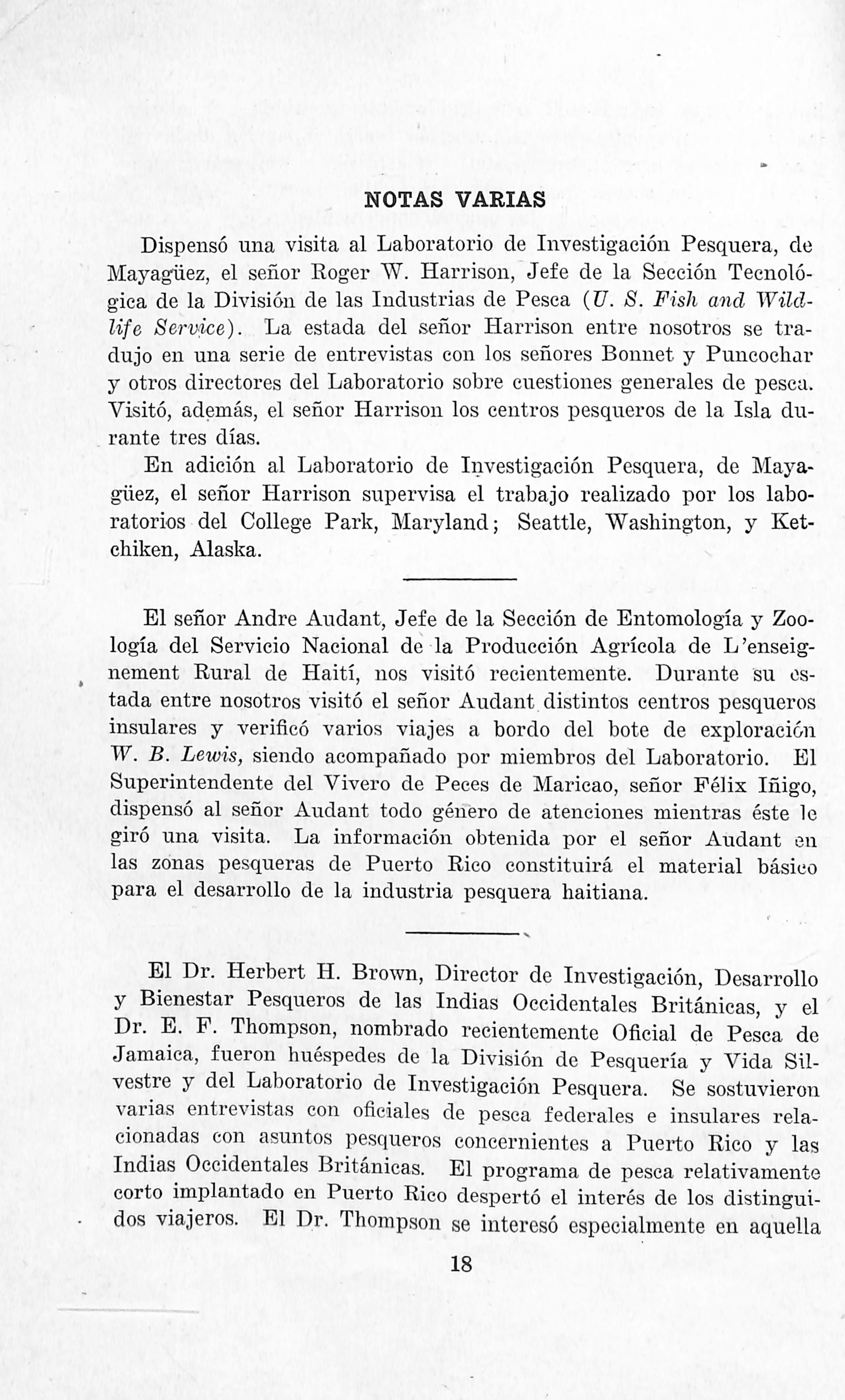
Dispensó una visita al Laboratorio de Investigación Pesquera, de Mayagüez, el señor Roger W. Harrison, Jefe de la Sección Tecnoló gica de la División de las Industrias de Pesca {TI. S. Fish and WildUfe Service). La estada del señor Harrison entre nosotros se tra dujo en una serie de entrevistas con los señores Bonnet y Puncochar y otros directores del Laboratorio sobre cuestiones generales de pesca. Visitó, además, el señor Harrison los centros pesqueros de la Isla du rante tres días.
En adición al Laboratorio de Investigación Pesquera, de Maya güez, el señor Harrison supervisa el trabajo realizado por los labo ratorios del College Park, Maryland; Seattle, Washington, y Ketchiken, Alaska.
El señor Andre Audant, Jefe de la Sección de Entomología y Zoo logía del Servicio Nacional de la Producción Agrícola de L'enseig^ nement Rural de Haití, nos visitó recientemente. Durante su es tada entre nosotros visitó el señor Audant distintos centros pesqueros insulares y verificó varios viajes a bordo del bote de exploración W. B. Lewis, siendo acompañado por miembros del Laboratorio. El Superintendente del Vivero de Peces de Maricao, señor Félix Iñigo, dispensó al señor Audant todo género de atenciones mientras éste le giró una visita. La informaeión obtenida por el señor Audant en las zonas pesqueras de Puerto Rico constituirá el material básico para el desarrollo de la industria pesquera haitiana.
El Dr. Herbert H. Brown, Director de Investigación, Desarrollo y Bienestar Pesqueros de las Indias Occidentales Británicas, y el Dr. E. F. Thompson, nombrado recientemente Oficial de Pesca de Jamaica, fueron huéspedes de la División de Pesquería y Vida Sil vestre y del Laboratorio de Investigación Pesquera. Se sostuvieron varias entrevistas con oficiales de pesca federales e insulares rela cionadas con asuntos pesqueros concernientes a Puerto Rico y las Indias Occidentales Británicas. El programa de pesca relativamente corto implantado en Puerto Rico despertó el interés de los distingui dos viajeros. El Dr. Thompson se interesó especialmente en aquella

parte de la industria pesquera que se refiere a los métodos de salar pescado para Ta cura de peces tropicales. También se interesó el Dr. Thompson en los peces de agua dulce importados por el Vivero de Peces de Maricao.
Un informe titulado "Prácticas y Costo de Operación de los Pes cadores de Puerto Rico" fué editado recientemente por la Estación Experimental de Agricultura de la Universidad de Puerto Rico con miras a ser distribuido. La documentación servida en este informe se obtuvo a través del esfuerzo combinado de la Estación Experi mental de Agricultura, la División de Pesquería y Vida Silvestre y el Laboratorio de Investigación Pesquera. Los interesados en la obten ción de este informe deberán solicitarlo al Director, en la Estación Experimental de Agricultura, Universidad de Puerto Rico, Río Pie dras, Puerto Rico. El informe se publicó bajo el rubro de "Mimeograph Report No. 21".
En la revista "Puerto Rico Ilhistrado", correspondiente al 17 de abril de 1943, vió la luz un artículo de Rafael Sacarello, titulado "Boquerón Como Indice de lo que Puede Esperarse de la Industria Pesquera". En este artículo se enfoca el progreso de una firma co mercial establecida en Boquerón.
El señor Pedro Vergne Roig, economista de pesca, becado por el Gobierno Insular, quien cursa su Master en Economía de Pesca en la Universidad de Maryland, nos informa que sus estudios progresan satisfactoriamente y que espera regresar muy pronto a Puerto Rico. El señor Roig ha visitado diversos centros pesqueros del Continente, entre los que figuran los de Gloueester, Mass., Boston, Nueva York, y Reedville, Virginia.
Tres estudiantes del Colegio de Agricultura y Artes Mecánicas realizan trabajos de investigación de pesca en el Laboratorio de Mayagüez. Estos estudiantes son la Sra. Carmen V. González Marini y los señores Jacinto Figarella y Rosendo Arce Presten. Estos reciben entrenamiento básico que les capacitará para trabajar en las pesque rías de Puerto Rico.
Como resultado de la actual emergencia bélica, la carne del tiburón figura en el Menú Nacional en forma de biftecs y productos de pes-

cado fresco y salado. El delicado sabor de la carne del tiburón se parece a la de otros pescados y se está haciendo popular. Debido a sus altas cualidade.s alimenticias, los productos salados formarán parte de la dieta con otros tipos de pescado salado.
La señorita Francisca Arana, ex empleada de la Estación Expe rimental de Estados Unidos en Maya^ez, desempeña actualmente el cargo de Técnico Auxiliar del Laboratorio de Investigación Pesquera desde el día 3 de mayo. Ella realiza trabajos relacionados con el envenenamiento esporádico que motiva el pescado.
Entre las personas que visitaron recientemente el Laboratorio de Investigación Pesquera figuran el Honorable Gobernador de Puerto Rico Dr. Rexford G. Tugivcll, y el señor Abe Fortas, Subsecretario del Departamento del Interior de Estados Unidos.
DEPARTMENT OF AGRICÜLTÜRE AND COMMERCE OF PUERTO RICO
DIVISION OF FISHERIES AND WILDIIFE CONSERYATION - SANTURCE,

San Juan, P. R. Insüuar Peocuiíkment Office
pRINTINfl DIVISION 1943
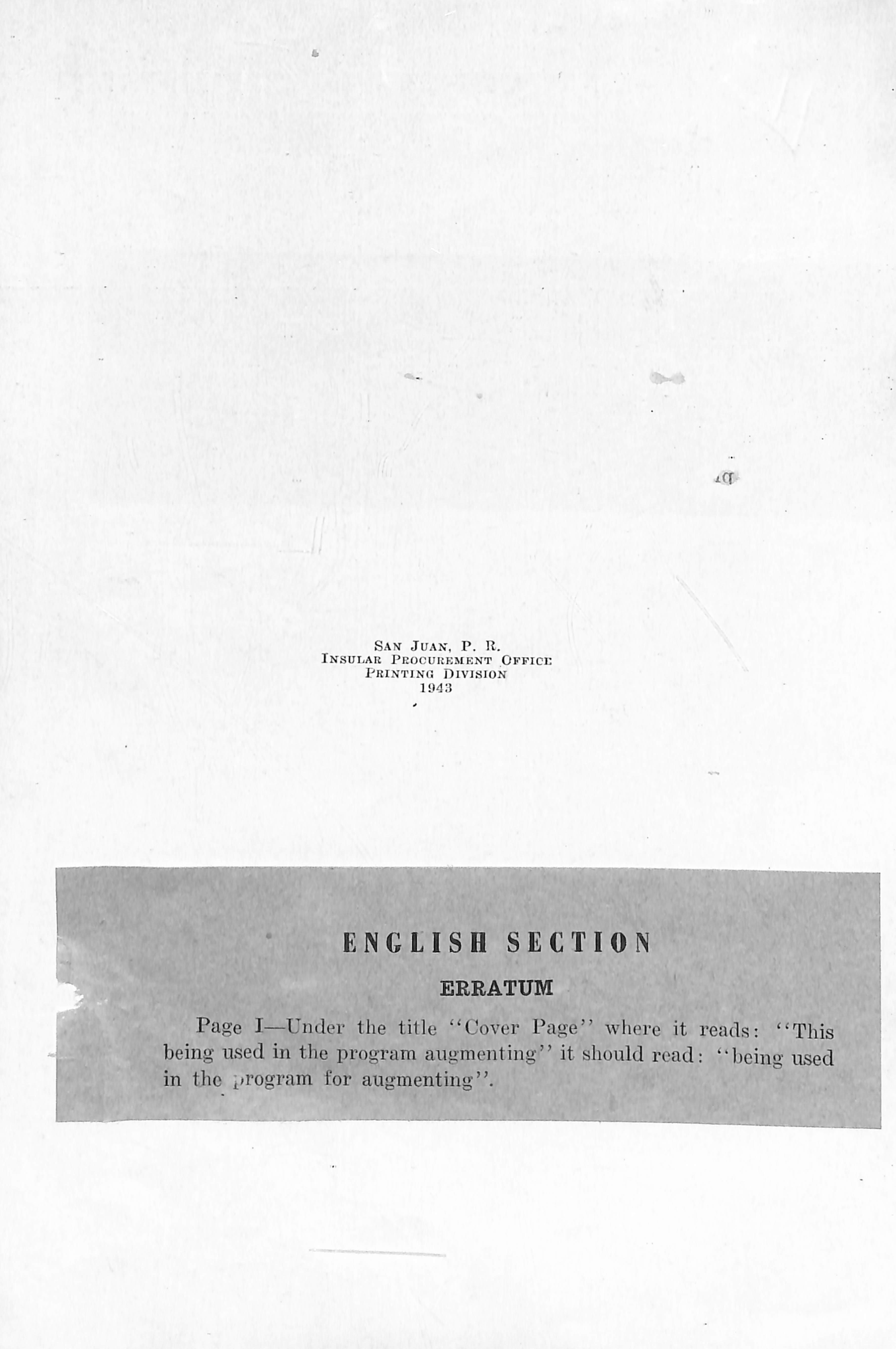
Page I—Under the tille "Cover Page" where it read.s: "This being used in the program aiigmenting" it sliould rcad: '"being iised in tlie program for augmenting

Published and distributed by the División of Fesheries & Wildlife Conservation of the Departmcnt of AKriculture and Commcrce of Puerto Rico with the cooperation of the Mayagüez Fishery Research Laboratory, of the Fish and Wildlife Service, U. S. Department of the Interior
I
1_A Method For The Wet-Salting of "Mixed" Fish. By J. F. PuNcocHVR and Luis R. Quiñones
2_A Method For The Tanning of Hand Linea And Neta. 5 By Luis R. Quiñones and J. F. Puncochar
3—Facts About Some of Our Most Important Food Fishes. 8 By Rafael Pérez Diez
4—Otter Trawl Net For Small Fishing Boats 12 By B. o. Knake and R. T. Whiteleather
5—Fishery Notes 24 THE COVER PAGE
THE VESSEL PICTURED ON THE FRONT COVER IS THE EXPLORATORY FISHING VESSEL "W. B. LEWIS" OF THE INSULAR DEPARTMENT OF AGRICULTURE AND QOMMERCE. THIS BEING USED IN THE PROGRAM AUGMENTING PUERTO RICO FISHERY RESOURCES.

Fernando A. Villamil, Coinmissioner of Agriculture and Commerce.
Luis A. Izquierdo, Assistant Commissioner of Agriculture.
■ José García Abreu, » Assistant Commissioner of Commerce.
Luis G. Bonnet, Chief, División of Fisheries and Wildlife Conservation.
Rafael Pérez Diez, Asst. Chief.
José E. Polanco, Fishery Technician.
Ventura Parnés, Jr. Fishery Engincer.
PfíDRO Yergne Roig, 'Fishery Economist.
Luis R. Quiñones, Fishery Technologist.
Félix Iñigo, Superintendent, Maricao Fish Hatchery.
Boris o. Knake, Captain, Vessel 17. B. Lewis.
J. F. PUNCOCIIAR, Technologist in Charge.
Richard T. Whiteleather, Fishery Engineer.
Clarence R. Lucas, Fishery Economist.
Francisca Arana, Fishery Technologist._
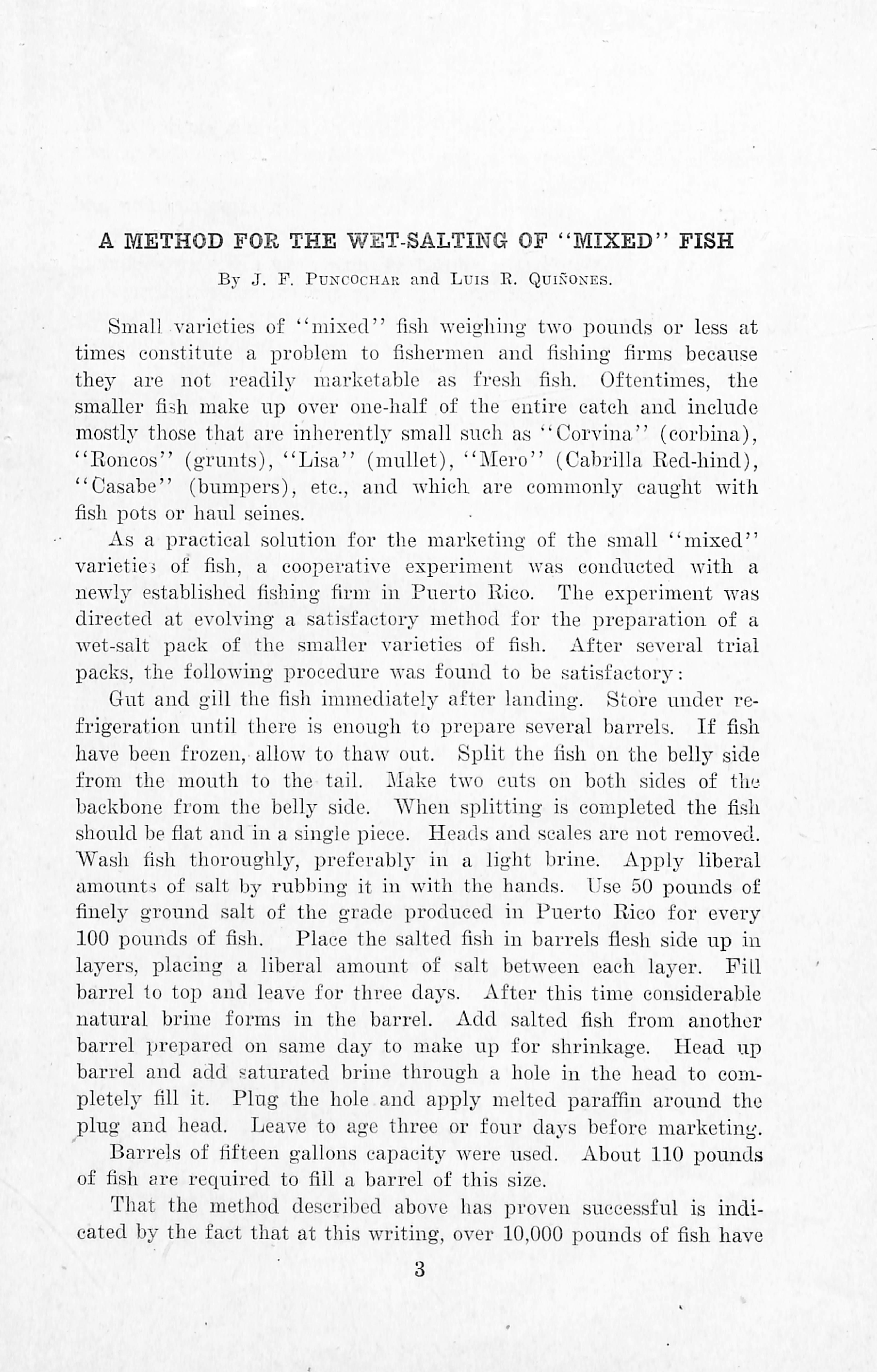
By J. P. Pdncochae find Luis E. Quiñones.
Small varioties of "mixed" fi.sli weigliiiig two pounds or less at times constitute a problem to fishermen and fisliing firms beeause tliey are not readily marketable as fresh fi.sli. Oftentimes, tlie smaller fish make up over one-half of tlie eiitire cateh and include mostly tho.se that are inherently small sueli as "Corvina" (corbina), "Roncos" (grimts), "Lisa" (mullet), "Mero" (Cabrilla Eed-liind), "Casabe" (bnmpers), etc., and -which are cominonly canglit witli fisli pots or haul seines.
As a practical solution for the marketing of tlie small "mixed" varieties of fish, a cooperative experiment was condneted witli a newly establislied fisliing fii-m in Puerto Rico. Tlie experiment ivas directed at evolving a satisfactory method for tlie preparation of a wet-salt pack of the smaller varieties of fish. After soveral tidal packs, the following procedure ivas found to be satisfactory:
Gnt and gilí the fish immcdiately after landing. Store under refrigeration until there is enoiigh to prepare several barréis. If fish have been frozen, allow to thaw ont. Split the fish on the belly side from the mouth to the tail. Make tivo cuts on both sides of the backbone from the belly side. When splitting is completed the fi.sh shonld be flat and in a single piece. Heads and scales are not removed. Wash fish thoronghly, preferably in a light brine. Apply liberal amonnts of salt by rubbing it in with the hands. Use 50 pounds of finely ground salt of the grade produced in Puerto Rico for every 100 pounds of fish. Place the salted fish in barréis flesh side up in layers, placing a liberal amount of salt between each layer. Pili barrel to top and leave for three days. After this time considerable natural brine forms in the barrel. Add salted fish from another barrel prepared on same day to make up for shrinkage. Head up barrel and add saturated brine through a lióle in the head to completely fill it. Plug the hole and apply melted paraffin around the plug and head. Leave to age three or four days before marketing. Barréis of fifteen gallons capacity were iised. About 110 pounds of fish are rcqiiired to fill a barrel of this size.
That the method described above has proven suecessful is indicated by the faet that at this writing, over 10,000 pounds of fish have

been prepared aiid marketed successfully. Keeping quality o£ tbe pack is good inasniuch as several barréis have been stored for periods of six montlis without any sigus of spoilage. Tliere is about 20 per cent loss in the original live weight o£ the fisli after eleaniug and shrinkage.
It is believed tbat this method of salting the smaller varieties of fish will do much toward avoiding waste and encourage fishermen to bring in largor catches. Also a pack of this type will help to supplant the imports of wet-salted fish and make available to the lower income group of people a good quality fish product. That wet-salted fish is a popular food in Puerto Rico is indicated by the fact that in the fiscal year 1923-1924 about 1,047,000 pounds were imported into the Island.

By Luis E. Quiñones and J. P. Puncochak.
Tlie preservation of fishing Unes aiid nets by "tanning" or "barking" dates back maiiy centuries and is practicad in varions forms by fishermen thronghout the world. That Puerto Eican fisbermen aro familiar witli tlie preservative properties of the tanuiii prosent in the bark of the red mangrove trae (Mangle colorado) was pointed out by the authors in a prcvious reportd After additional experiments, the inethod of extracting tannin from red mangrove bark as described in the carlier report was simplified so that an extract for use in the preservation of fishing lines and nets could be prepared by fishermen on the spot. That the method generally used by the fishermen (rubbing the root tips of the red mangrove tree over the twine until a brown protective coating was obtained) could be improved upon so that mox'e complete penetration of the pre servativo into the twine would result, thus assuring longer preserva tion, was obvious.
Red mangrove trees grow in or near tidal waters at many fishing centers, thus enabliiig fishermen to gather the raw material and prepare whatever qúantity of extract is needed fór immediate use. The procedure which follows Avas found to be satisfactory for obtaining an extract for fishing line and net preserAmtion;
A rotary extractor (Pig. I) was found to be an efficient apparatus for the removal of the tannin. It consists of a 15 gallón barrel the inside of which is fitted with three "baffle boards" spaced at equal distances and running the cutiré length of the barrel. A water-tight Avedge door five liy five inches square is fitted into the barrel. A hole for discharging the extract is also provided. The barrel is then mounted on a suitable stand.
Boiling hot Avater is placed into the extractor and tAvo pounds of freshly cut bark are added for each gallón of Avater. After rotating the extractor for a period of one-half hour, the extract is transferred into a Avater-tight barrel and alloAved to cool. The tannin solution is noAv ready for use. The hand lines or nets are placed into the
{^) Luis R. Quiñones nnd J. F. Puncocliar, 1943. Preliminary Report on tho Practical UÍilization of Mangrove Bnrk. Fishery Bulletin of Puerto Rico, March, 1943, pp. 8—12.
extract aiicl kept submergod bj' appljáiig stone weights. Tlie time neeessai'y for tlie solution to strike throngh Avill vary aecordiiig to tke size of tbe twine, but usually does not esceod a period of 24 hours. The penetratioii of tlie extract inte tlie tAviiie can be cliecked by periodically mitwisting the t-\vine to note if any wbite por.tion is visible. After tlie tanniii has struck tbrongli, the lines or nets are drained back into the barrel.

In order to assure good preservative qualities and to prevent-the tannin from washing out of the twine, it is necessary that the treated lines or nets be snl)jectcd to a fixing Ijath. A solution prcpared in the proportion of four onnces of potassium dichromate for eacli twelve gallons of boiling water is nsed for the fixing bath. The chemical should be completely dissolved beforc being nsed. The wet bnt drained tanned lines or nets are boiled in the solntion for a period of fifteen minutes aftcr which time they are drained and thoroughly washed in cold water. If the lines or nets are not to be nsed immediately, care shonld be taken to dry them in a shadj'^ place.

The tannin extract can be lísed ovar again but it should be heated to the boiling point, ene potind of fresh bark added for every gallón of solution, and extractad for a half-hour for each subsequent treatment.
In those fishing centers where the above procedure is used, it is reported that a definite advantage over the usual treatment with linseed oil results and that on storage, lines and nets do not deterió rate as rapidly as those treated with linseed oil. Another advantage ovar the linseed oil treatment is that the pliability of the hets after being treated is much better. The frequency of treating fishing gear with the extract will depend upon the amount of fishing carried out. If the gear is used every clay it is recommencled that treatment be car idad out once a month. When periodic fishing is carried out, one treatment every threc or four months is sufficient.
The preservation of fishing lines and nets to prolong life espeeially during wartime should be every fisherman's patriotic duty. Demands of the armed forces for materials such as twine, netting, ropa, etc., are making these materials increasingly difficnlt to obtain. Those materials that are made available for the fishing industry should therefore be utilized to the best advantage through proper cara and preservation.
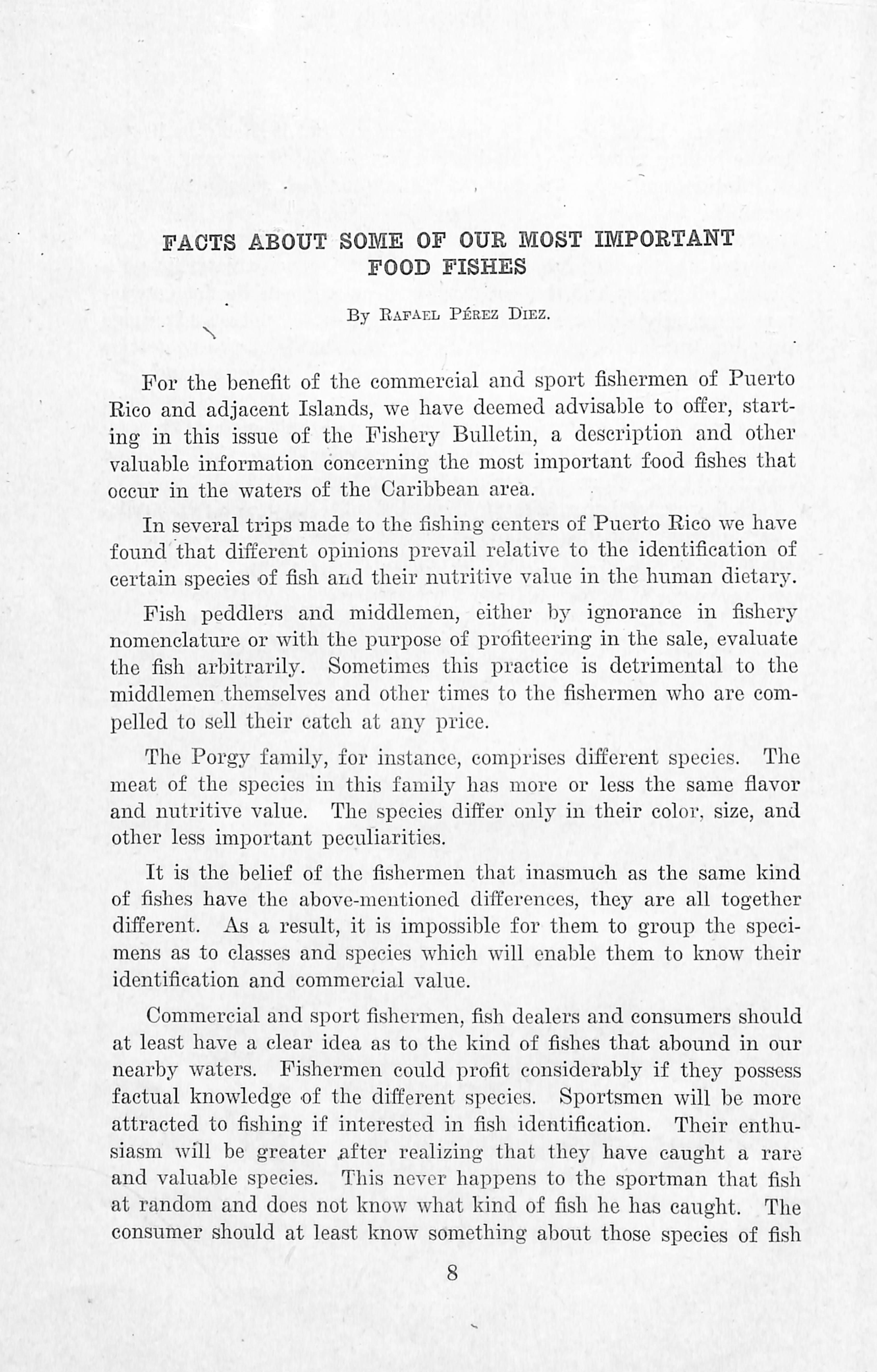
By Rafael Pérez Diez.
For the benefit of the commereial and sport fisliermen of Puerto Rico and adjaceiit Islands, we have doemed advisable to offer, starting in this issue of tlie Fishery Bulletin, a dcscription and other valuable information concerning the most important food fishes that occur in the waters of the Garibbean area.
In several trips raade to the íishing centers of Puerto Rico we have found that different opinions prevail relative to the identificatioii of certain species of fish and their nutritivo valué in the human dietary.
Fish peddlers and middlemen, either by ignorance in fishery nomenclature or with the purpose of profiteering in the sale, evalúate the fish arbitrarily. Sometimos this practico is detrimental to the middlemen themselves and other times to the fishermen who are compelled to sell their catch at any price.
The Porgy family, for instancc, comprises dilíereut species. The meat of the species in this family has more or less the same flavor and nutritivo valué. The species differ only in their color, size, and other less important peculiarities.
It is the belief of the fishermen that inasmuch as the same kind of fishes have the above-meiitioned differences, they are all together diiferent. As a result, it is impossible for them to group the specimens as to classes and species which will enable them to know their identification and commereial valué.
Commereial and sport fishermen, fish dealers and consumers should at least have a clear idea as to the kind of fishes that abound in our nearby waters. Fishermen could profit considerably if they possess factual knowledge of the different species. Sportsmen will be more attracted to fishing if interested in fish identification. Their enthusiasm will be greater after realizing that they have caught a rare and valuable species. This never happens to the sportman that fish at random and does not know what kind of fish he has caught. The consumer should at least know something about those species of fish
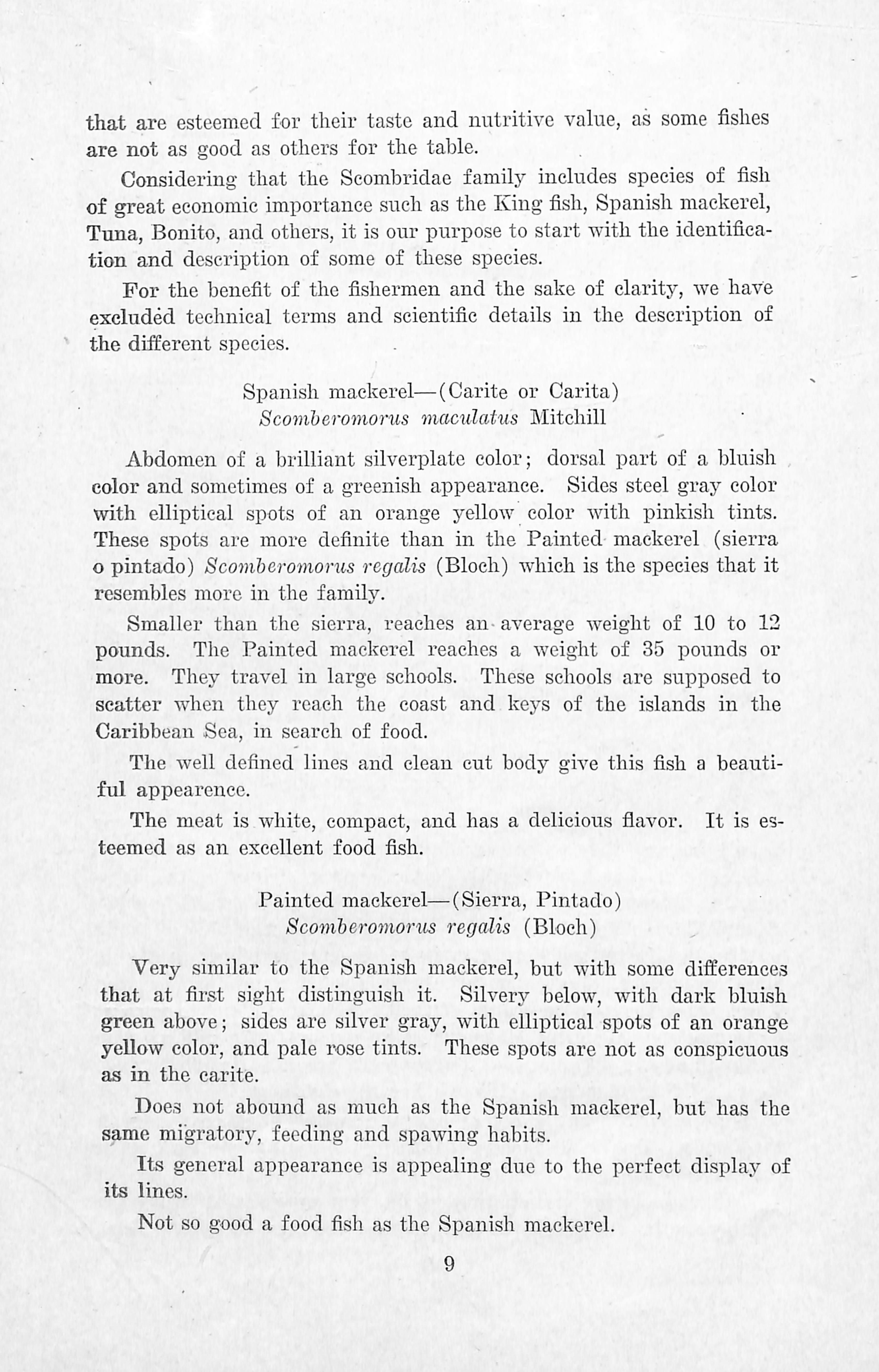
that are esteemed for tlieir taste and nutritive valué, as some fishes are not as good as others for the table.
Considering tliat tlie Scombridae family includes species of fish of great economic importance such as the King fish, Spanish mackerel. Tuna, Bonito, and others, it is our piirpose to start with the identification and deseription of some of these species.
For the henefit of the fishermen and the sake of clarity, we have excludéd technieal terms and seientific details in the deseription of the diiferent species.
Spanish mackerel—(Carite or Carita)
Scomheromorus maculatus Mitchill
Abdomen of a hrilliant silverplate color; dorsal part of a hluish color and sometimes of a greenish appearance. Sides steel graj^ color with elliptical spots of an orange yellow color with pinkish tints. These spots are more definite than in the Painted mackerel (sierra o pintado) Scomheromorus regalis (Bloch) which is the species that it resembles more in the family.
Smaller than the sierra, reaches an - average weight of 10 to 12 pounds. The Painted mackerel reaches a weight of 35 pounds or more. They travel in large schools. These schools are supposed to seatter when they reach the coast and keys of the islands in the Caribhean Sea, in search of food.
Tlie well defined lines and clean cut hody ghm this fish a beautiful appearence.
The meat is white, eompact, and has a delicious flavor. It is es teemed as an excellent food fish.
Painted mackerel—(Sierra, Pintado)
Scomheromorus regalis (Bloch)
Very similar to the Spanish mackerel, but with some diiferences that at first sight distinguish it. Silvery below, with dark hluish green above; sides are silver gray, with elliptical spots of an orange yellow color, and palé i'ose tints. These spots are not as conspicuous as in the carite.
Does not aboujid as much as the Spanish mackerel, but has the same mi'gratory, feeding and spawing habits.
Its general appearance is appealing due to the perfect display of its lines.
Not so good a food fish as the Spanish mackerel.
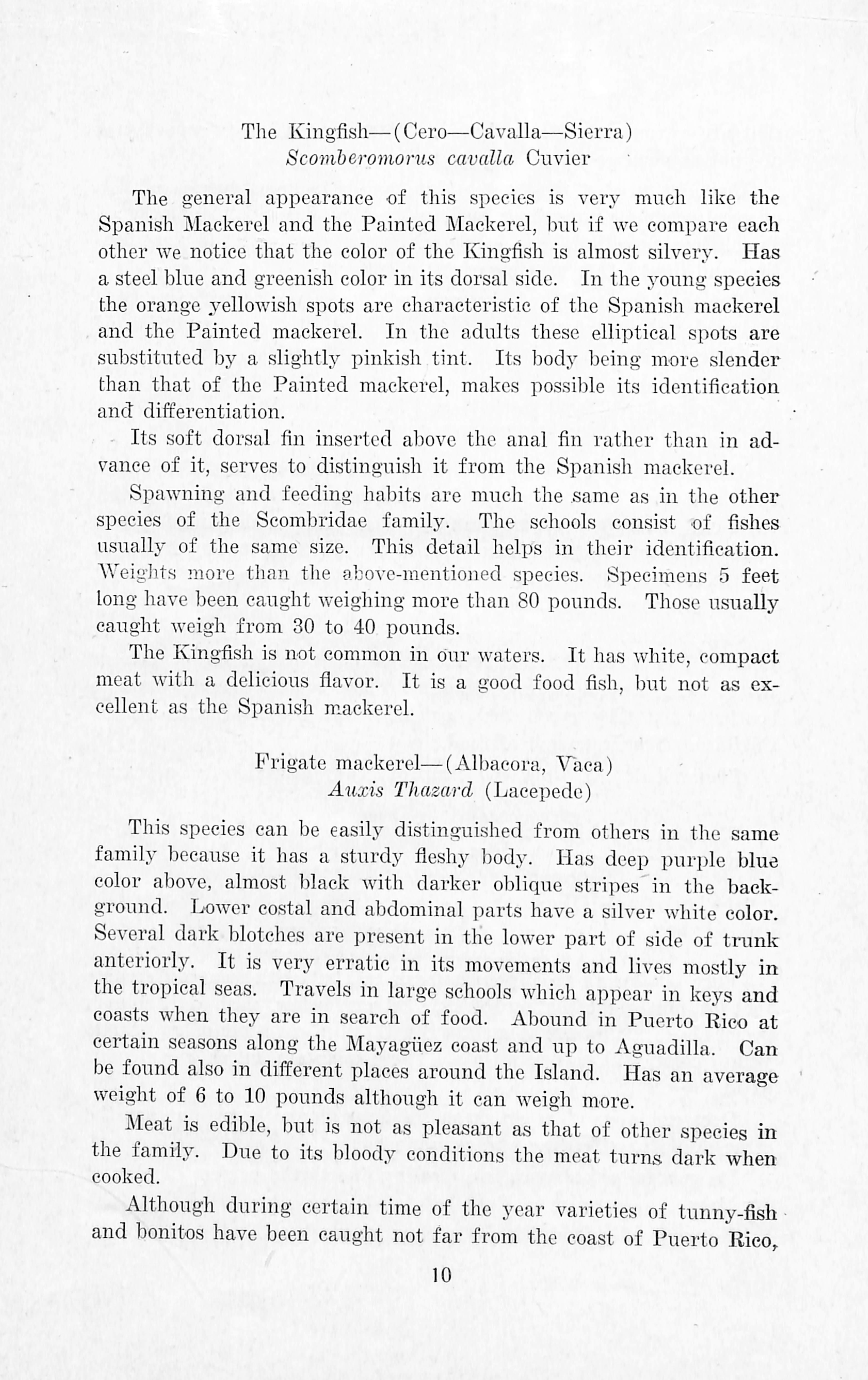
The Kingfish—(Cero—Cavalla—Sierra)
Scomheromorus cavalla Cuvier
The general appearanee of tliis speeios is very mueh like the Spanish ülackerel and the Painted Maekerel, but if we compare each othor we notice that the color of the Kingfish is alniost silvery. Has a steel bine and greenish color in its dorsal side. In the young species the orange yellowish spots are charaeteristic of the Spanish maekerel and the Painted maekerel. In the adnlts these elliptieal spots are substituted by a slightly pinkish tint. Its body bcing more slender than that of the Painted maekerel, makcs possil)le its identifieation and differentiation.
Its soft dorsal fin insertcd abovc the anal fin rather than in ad vanee of it, serves to distingnish it from the Spanish maekerel.
Spawning and feeding halfits are mueli the same as in the other species of the Seombridae family. The sehools eonsist of fishes usually of the same size. This detall helps in their identifieation. Weiglits more than the above-mentioied species. Specimens 5 feet long have been canght weighing more than 80 ponnds. Those nsually caught Aveigh from 30 to 40 ponnds.
The Kingfish is not eommon in onr waters. It has white, eompact meat with a delieions flavor. It is a good food fi.sh, bnt not as exeellent as the Spanish maekerel.
Frigate maekerel—(Albaeora, \'aea)
Auxis Thazard (Laeepedc)
This species can be easily distingnished from others in the same family beeanse it has a stnrdy ñeshy body. Has deep pnrple bine color above, almost black with darker obliqne stripes in the baekgronnd. Lfower costal and abdominal parts have a silver white color. Several dark blotehes are present in the lower pai't of side of tmnk antcriorly. It is very erratic in its movements and lives mostly in the tropical seas. Travels in large sehools which appear in keys and eoasts when they are in seareh of food. Abonnd in Pnerto Rico at certain seasons along the Mayagiiez coast and np to Aguadilla. Can be fonnd also in diíTerent places aronnd the Island. Has an average weight of 6 to 10 ponnds althongh it can weigh more.
Meat is edible, bnt is not as pleasant as that of other species in the family. Dne to its bloody conditions the meat tnrns dark when cooked.
Althongh dnring certain time of the year varieties of tnnny-fish • and bonitos have been canght not far from the coast of Pnerto Rico,

autliorities like J. T. Nichols and B. W. Evermann are of the opinión that this species do not dwell in our waters.
Due to tlieir sporadic presence in our coasts they liave no definite valué to the coramercial fislieries.
On aceount of the aforementioned, these species will not be considered or diseussed in this work.
1. Fishes & Pisheries of P. E.—B. W. Evermann.
2. The fishes of North and Micldle América—Jordán Evermann.
3. Scientific Survey of Porto Rico and the Virgin Islands—J. T. Nichols.
4. Big Game Angler's Paradise—Moise N. Kaplan.
By B. O. Knake and E. T. Whiteleathee.

"Ottei* trawl" is tlie ñame of that type of bottom net wHch is fished by to^ving it behind a boat as shown in the above sketch. The mouth of the net is held open by the action of two doors which, when drawn through the water, have a reaction similar to that of a kite in the air. Large otter trawls operated from steam of Diesel powered boats have for many years been one of the primary gears used for taking enormous qiiantities of bottom fish on the New England Banks, North Sea and in other parts of the world. These large trawls are intricate in design and the product of many years of experimentation and constant improvement. The vessels using them have special winches and other deck equipment specifically designed for trawl opcration. Bearing in mind that the regular fishing boat nsed in the Puerto Riean fisheries is neither large enough ñor sufficiently equipped to make use of a large commercial trawl, experiments have been carried out during the past year in designing and adapting a small otter trawl to the sailboats and launches which are common to the fisheries of Puerto Rico.
A "box net" made of cotton webbing is probably one of the simplest types of otter trawls to construct and at the same time utilizes most of the fishing principáis of the larger and more complicated trawls. Several of the following pages are devoted to the details of the construction of a box net trawl and otter doox's suitable for use with a small sailboat or ordinary launch. Before going into the construction details of this apparatus, however, it would Ixe ad-

visable to briefly point out the advantages as well as the liniitations of a device of this kind when used in waters along tbe Coast of Puerto Eico. In making an appraisal of its eomraercial valué these are points tbat would be raised by any fisherman who is totally unfamiliar with this type of gear.
As to advantages, this trawl is eapable of taking small market fishes s'uch as corbina, dienton, barbuda, machete, ronco, coreobado, robalo, and other inshore fishes that occur in the shallow waters (1-5 fathoms) of many of the bays along the coast line of Puerto Eico. When tlie'fish were reasonably abundant our experience in fishing these species with the small trawl showed that with less eífort good catches could be made as compared with catches of any of the other types of gear now being used in the various fishing localities.
In taking small bait fishes as manjúa and machuelo the trawl has a definite advantage over the usual cast net method of catching bait. At times when fishermen were bitterly complaining that they were unable to secure bait with their cast nets and therefore unable to do fishing with their handlines, the trawl Avhen set out produced more than sufficient bait for their needs. This is an important point inasmuch as handlining is one of the chief methods of fishing in Puerto Eico, and without bait a handliner cannot work. Usually, when the trawl is liauled aboard the boat it contains a great variety of sizes and species of fish and after the larger marketable fish are sorted out there remains a quantity of smaller fishes suitable not only for handline bait, but also for nasa bait. Every hour saved by a fisher man in searching for bait means an extra hour of fishing; a matter of considerable significance during present wartime conditions when the hours of fishing are severely restricted.
The trawl can also be used in combination with other gears presently fished by Puerto Eican fisherman, for example, the beach seine. The beach seine requires about eight men for operation and frequently is set out and hauled back only with hopes of making a good cateh. Such a procedure often results in "water hauls" and a great amount of lost effort which partially could be eliminated by making a trial drag with a trawl over the seine grounds prior to setting out the seine. If results of the trial drag indicated that bottom fish are abundant enough to warrant setting the haul seine, then the seine could be set with more positive assurance that fish would be caught. A trawl also has access to fish that sometimos occur
Sell/ WEOG-a
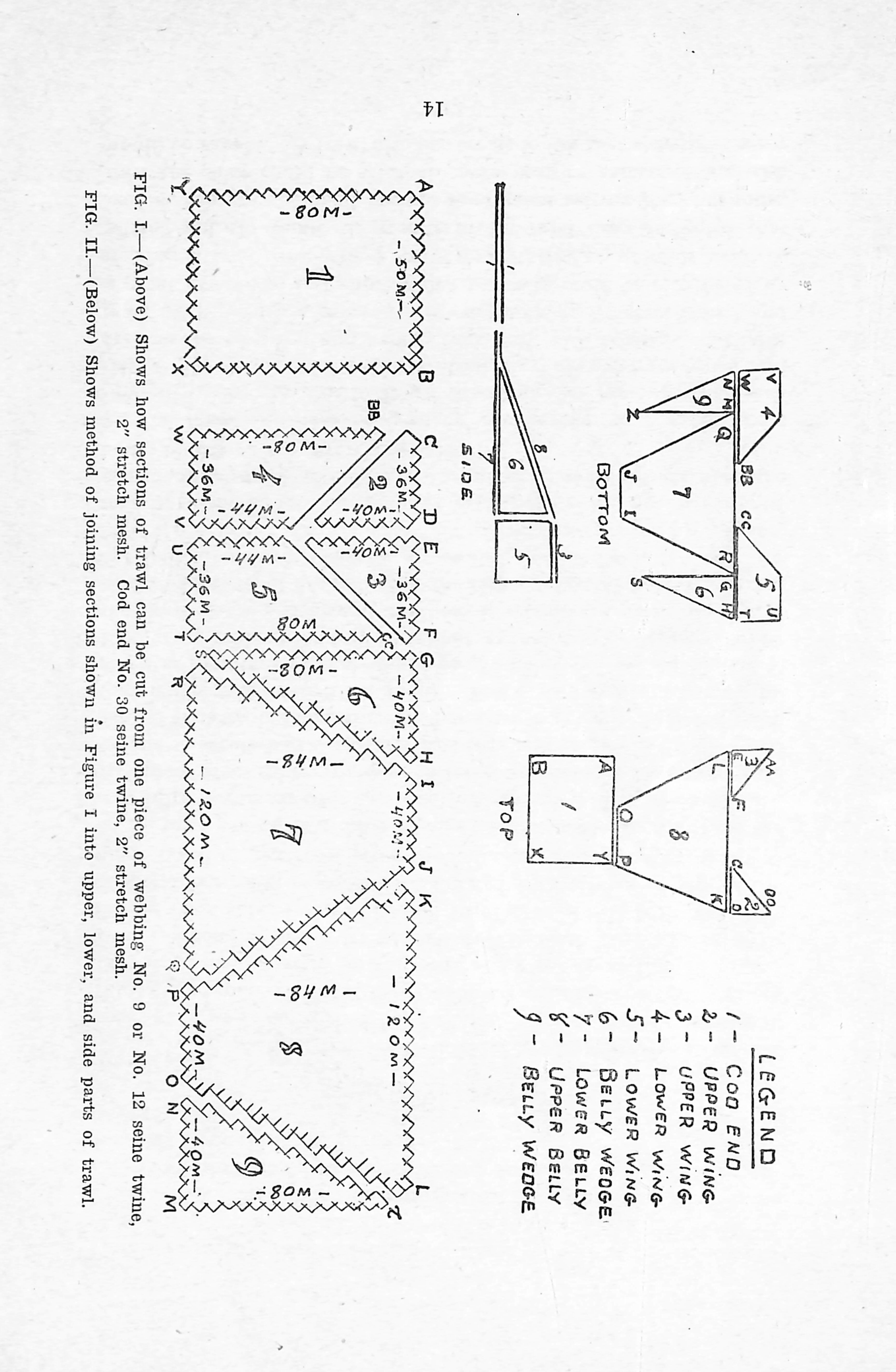
FIG. I.—(Above) Shows how sections of trawl can he cut from ene piece of wehhing No. 9 or No. 12 seine twine, 2" stretch mesh. Cod end No. 30 seine twlne, 2" stretch mesh.
FIG. II.— (Below) Shows method of joinlng sections shown iu Figure I into upper, lower, and side parts of trawl.

off-shore just beyond tlie workable radiiis of the beach seine. Considering these points it is probable that maiiy beach seiners could prófit by working out this eombination of gear to snit their individual needs.
' The limitations of trawl Jlshing are chiefly goveriied Ijy the type of bottoin on which the flsh occur. As may be seen in the first sketch, t.his gear is draggecl aloiig the bottom with the foot rope, doors, aud cod end in direct contact with the bottom. Therefore, the bottom must be reasonably free from coral growth, rocks, oíd anchors, deadheads and other óbstimctions. In general, however, areas that are suitable for beach seining are suitable for this type of trawding. In many of the bays where rivers enter the ocean, small deltas have been built up fi-om sediment carried out by the rivcr. Good areas for use of a small trawl are also found in these parts. Several locations including Añasco Bay, Tallaboa Bay, Jobos Harbor, Puerto Real Bay, Guayanilla Bay, and Loíza River Bay have been examilied by fishing a trawl and have proven to be satisfactory for operation of this gear. Catches during the experimental fishing varied considerably, but the máximum catch of approximately ninety-five (95) pounds of assorted fish per hour of dragging was made in Añasco Bay and in Puerto Real Bay. Prequcntly much less was taken, so that any attempt to set forth a definite guarantee of what might l)e expeeted from tlús apparatus would be out of the question. Any fisherman intercstcd in tiying a new gear of this kind would have to mako those determinations himself; and as he gained experience, his catches would undoubtedly increasc. It is unfortunate that much of the bot tom found in the waters arouiid Puerto Rico is too irregular and too rough to allow unlimited trawl fishing, nevertheless, this gear should prove its valué in the areas where it can be utilized.
The season of the year during which the best fishing will be encountered will vary in respect to the different localities along the Coasi, and in this regard no hard and fast rule may be applied concerning the most favorable fishing time. Records from our experiments showed in general that the fish were more abundant and catches were larger during the rainy season. At this time the bay waters becomc somewhat brackish owing to the large quantity of fresh water discharged into the bays from the confiuent streams. The fish also appear to collect in thcm to obtain any food that may be carried into the bay by the stream run off. Fisherman acquainted with these waters already have a good knowledge of the time of appcarance of the various species of fish, and therefore, little emphasis need be given to this point.

FIG. III.—Illustration of trawl after all sections shown in Fig. 11 have been joined. Letters and numbers correspond to sections shown in Figs. I and II.
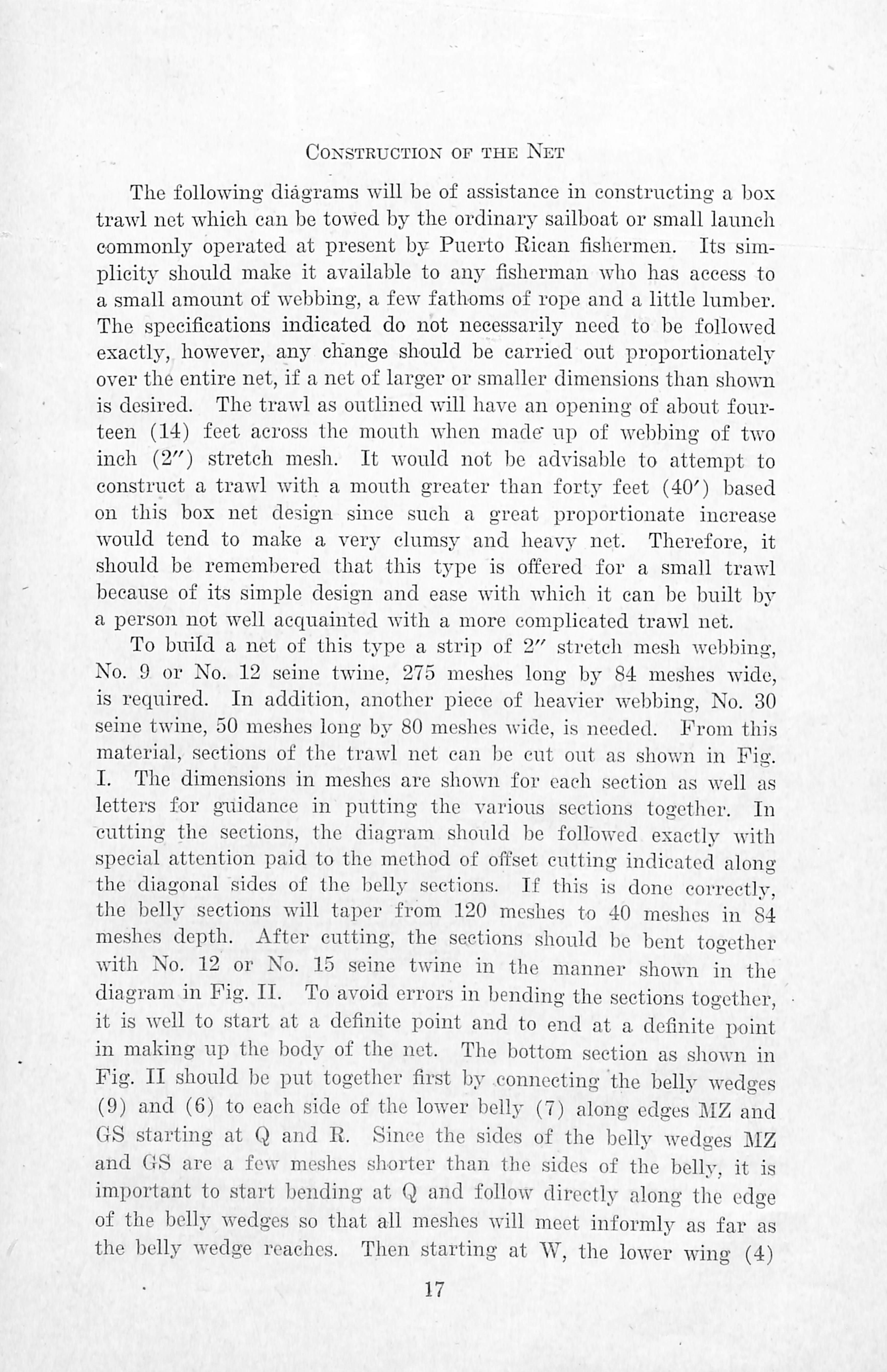
Tlie following diágrams will be of assistance iii constructing a box trawl net which can be towed by the ordinary sailboat or small launcli commonly operated at present by Puerto Riean fisliermen. Its simplieity should make it available to any fislierman wlio has aceess to a small amount of webbing, a few fathoms of rope and a little lumber. The specifications indicated do not neeessarily need to be followed exactly, however, any elíange should be carried out proportionately over the entire net, if a net of larger or smaller dimensions than shomi is desired. The trawl as outlined will have an opening of about fourteen (14) feet across the mouth when made" np of Avebbing of two inch (2") stretch mesh. It would not l)e advisable to attempt to construct a trawl with a mouth greater than forty feet (40') based 011 this box net design sinee such a great proportionate inerease wonld tend to make a very clumsy and heawv' net. Therefore, it should be remembered that this type is oífered for a small trawl because of its simple design and ease with which it can be built by a person not well acquainted with a more complieated trawl net.
To bnild a net of this type a strip of 2" stretch mesh welibing, No. 9 or No. 12 seine twine. 275 meshes long by 84 meshes wide, is required. In addition, another piece of heavier webbing, No. 30 seine twine, 50 meshes loiig by 80 meshes wide, is needed. From this material, sections of the trawl net can be cnt out as shown in Fig. I. The dimensions in meshes are shown for eaeh section as well as letters for gnidance in pntting the various sections together. In cutting the sections, the diagram should be followed exactly with special attention paid to the method of offset cntting indicated along the diagonal sides of the belly sections. If this is done correctly, the belly sections will tapcr from 120 meshes to 40 meshes in 84 meshes depth. After cutting, the sections should be bent together with No. 12 or No. 15 seine twine in the manner shown in the diagram in Fig. II. To avoid errors in bending the sections together, it is well to start at a definite point and to end at a definite point in making up the body of the net. The bottom section as slmwn in Fig. II should be put together first by connecting the belly wedges (9) and (6) to each side of the lower belly (7) along edges MZ and GS starting at Q and R. Since the sides of the belly Avedges MZ and GS are a few meshes shorter than the sides of the belly, it is important to start bending at Q and follow direetly along the edge of the belly Avedges so that all meshes Avill meet informlj^ as far as the belly Avedge rcachcs. Then starting at W, the loAver Aving (4)
■ Headitope teo.
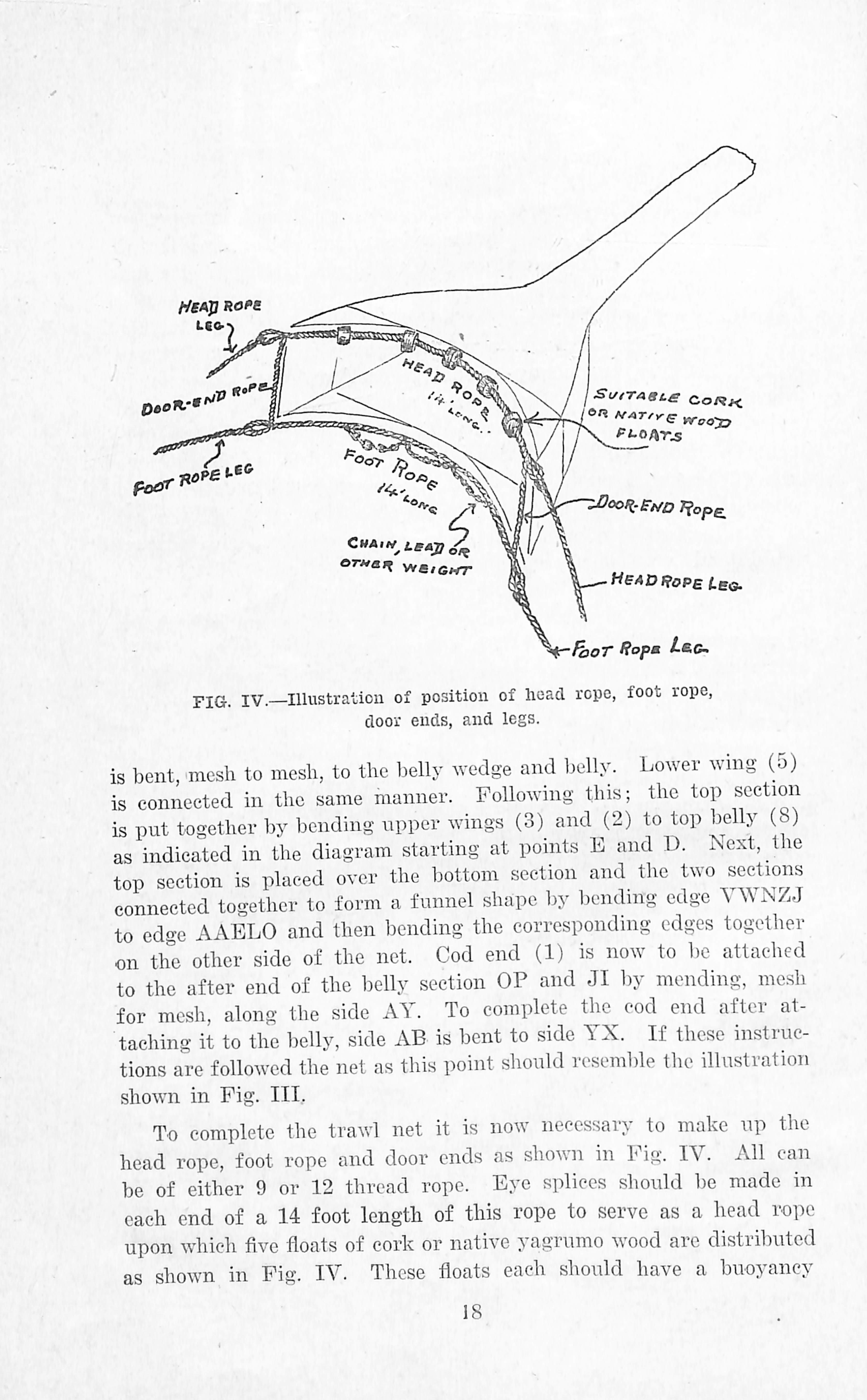
FIG. IV. Illustrai/iou of position of head rope, foot rope, dooi- ends, and legs.
is bent, mesh to mesh, to the belly wodge and belly. Lower wing (5) is connected in tbc same manner. Followmg this; tlie top scetion is put togetlier by bcnding upper wings (3) and (2) to top belly (8) as indieated in the diagram starting at points E and D. Next, the top section is placed ovcr the bottom section and the t\YO sections connected together to form a funnel shape by bcnding cdge VWNZJ to cdge AAELO and then bcnding the correspondmg edges together on the other sido of the net. Cod end (1) is now to l)c attached to the after end of the belly section OP and JI liy mending, mesh for mesh, along the side AY. To complete the cod end after attaching it to the belly, side AB is bent to side YX. If thcse instructions are followed the net as this point should resemlde the illustration shown in Fig. III,
To complete the trawl net it is now necessary to make np the head rope, foot rope and door ends as shown in Fig. IV. All can be of either 9 or 12 thread rope. Eye splices shonld be made in each end of a 14 foot length of this rope to serve as a head rope upon which five floats of cork or native yagrumo wood are distributcd as shown in Fig. IV. These floats each should have a buoyancy
Ben-y
SEcTioH
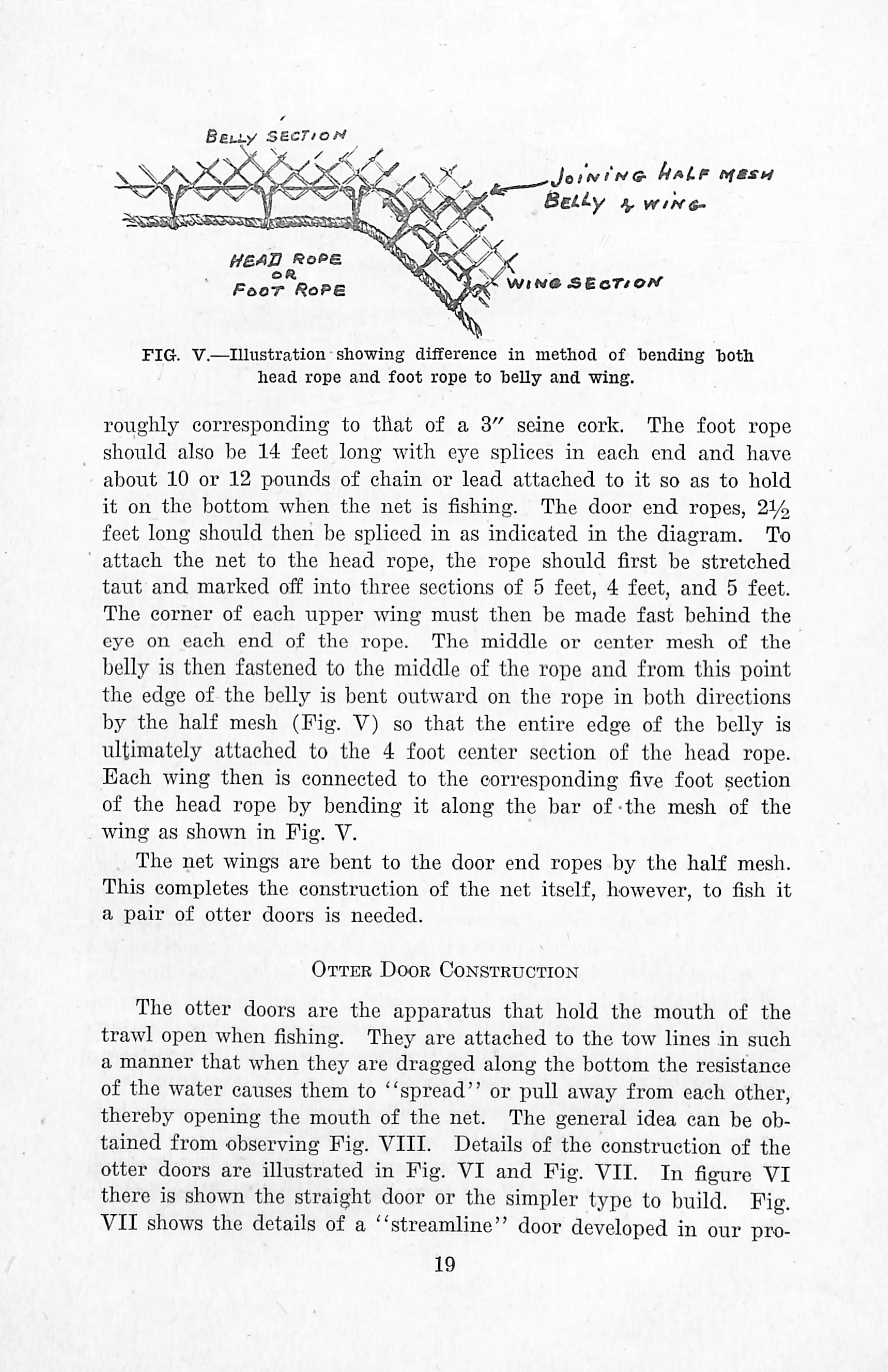
Beí^y V yr/'/ys-
HB-AU ftoPS oK. FaoT RoPB yjtNa sBoTiotf
FIG-. V.—Illustration showing difíerence in method of bending botli head rope and foot rope to belly and wing.
roughly corresponding to tñat of a 3" seine cork. The foot rope should also be 14 feet long with eye spliees in each end and have about 10 or 12 pounds of chain or lead attaehed to it so as to hold it on the bottom when the net is fishing. The door end ropes, 21/^ feet long should then be spliced in as indicated in the diagram. To attaeh the net to the head rope, the rope should first be stretehed taut and marked off into three sections of 5 feet, 4 feet, and 5 feet. The córner of each upper wing must then be made fast behind the eye on each end of the rope. The middle or center mesh of the belly is then fastened to the middle of the rope and from this point the edge of the belly is bent outward on the rope in both directions by the half mesh (Fig. V) so that the entire edge of the belly is ultimately attaehed to the 4 foot center section of the head rope. Each wing then is connected to the corresponding five foot section of the head rope by bending it along the bar of-the mesh of the wing as shown in Fig. V.
The net wings are bent to the door end ropes by the half mesh. This completes the construction of the net itself, however, to fish it a pair of otter doors is needed.
The otter doors are the apparatus that hold the mouth of the trawl open when fishing. They are attaehed to the tow lines in such a manner that when they are dragged along the bottom the resistance of the water causes them to "spread" or pulí away from each other, thereby opening the mouth of the net. The general idea can be obtained from observing Fig. VIII. Details of the construction of the otter doors are illustrated in Fig. VI and Fig. VII. In figure VI there is shown the straight door or the simpler type to build. Fig. VII shows the details of a streamline" door developed in our pro-
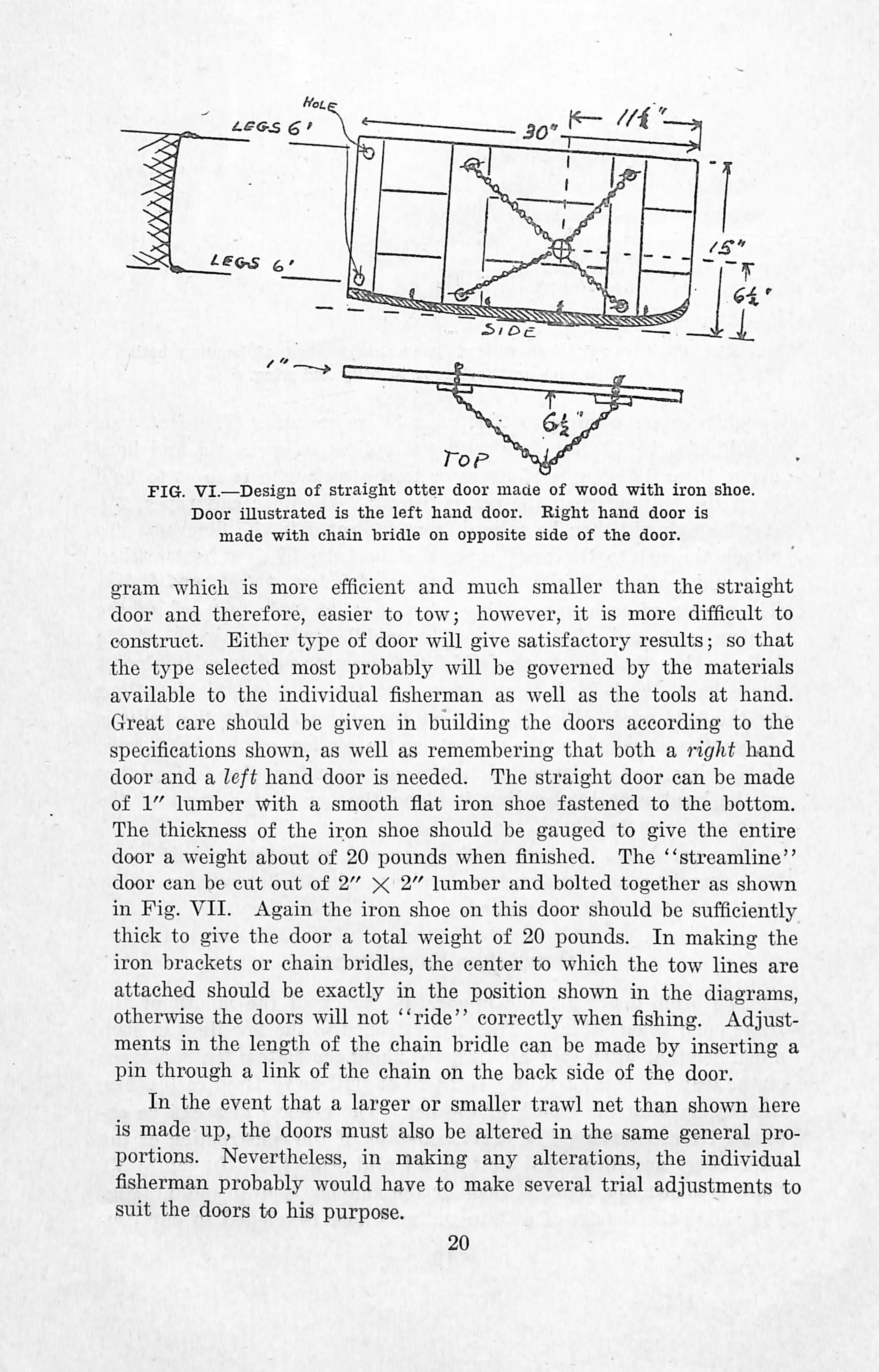
FIG. VI.—Design of straight otter door maüe of wood with iron shoe. Door iUustrated is the left hand door. Kight hand door is made with chaín bridle on opposite side of the door.
gram wliicli is more efñcient and much smaller than the straight door and therefore, easier to tow; however, it is more diffieult to constmet. Either type of door will give satisfaetory resnlts; so that the type selected most probably will be governed by the materials available to the individual fisherman as well as the tools at hand. Great eare should be given in buüding the doors aecording to the specifications shown, as well as remembering that both a right hand door and a left hand door is needed. The straight door can be made of 1" lumber with a smooth flat iron shoe fastened to the bottom. The thiekness of the iron shoe should be gauged to give the entire door a weight about of 20 pounds when finished. The "streamline" door can be cut out of 2" X 2" lumber and bolted together as shown in Fig. VII. Again the iron shoe on this door should be sufSciently thiek to give the door a total weight of 20 pounds. In making the iron brackets or chain bridles, the center to which the tow lines are attached should be exaetly in the position shown in the diagrams, otherwise the doors will not "ride" correctly when fishing. Adjustments in the length of the chain bridle can be made by inserting a pin through a link of the chain on the back side of the door.
In the event that a larger or smaller trawl net than shown here is made up, the doors must also be altered in the same general proportions. Nevertheless, in making any alterations, the individual fisherman probably would have to make several trial adjustments to suit the doors to his purpose.
f /Vote To tAAK^ ¿Etf

FIG. VII.—Design of "stream line" otter door made of wood ■witli iron shoe. This door is more eíñcient tlian straight door shown in Fig. VI, iDut also requires greater precisión in construction.
When the trawl net, doors, tow lines, and buey line have been rigged up as sbown in Fig. VIII, tbe entire outfit is ready for service. Tbe cod end must now be elosed by a tnrn of tbe buoy line after wbicb tbe net sbould be piled on tbe stern of tbe boat witb tbe doors and all lines clear so tbat tbey may be paid ont wbile tbe boat is under way. Wbile the boat is on a straight course and slowly under way the buoy and buoy line sbould be paid out over tbe stern, tben tbe eod end, belly and foot and bead ropes put over in tbat order. At tbis stage tbe legs are cbecked up until tbe foot rope sinks and floats of tbe bead rope are on tbe surface of tbe water to assure tbat all of tbe net is opened and clear. Tben slack is given slowly enougb to maintain tensión on tbe net, and tbe doors dropped over tbe stern simultaneously. Tbe bridle is cbecked up until tbe forward speed of tbe boat causes tbe doors to "spread open". Wben it is seen tbat tbe doors are spreading properly and beginning to sink, tben tbe tow line is paid out slowly until sufficient line is out to aUow tbe trawl to fisb in tbe bottom. Tbe tow line tben sbould be made fast to a bit or eleat and the boat given full headway to drag tbe net over tbe bottom.
Wí* (VSFO FCR G>ETni/& TRAv^U. _ ^ BACK ilFTÓWtMLlUB OR, LE&S PART)
6í/0^ LiUE^
«Jt Cojf BU)J CLOSEJJ 8y TuRtf op éuoy P «-'"e
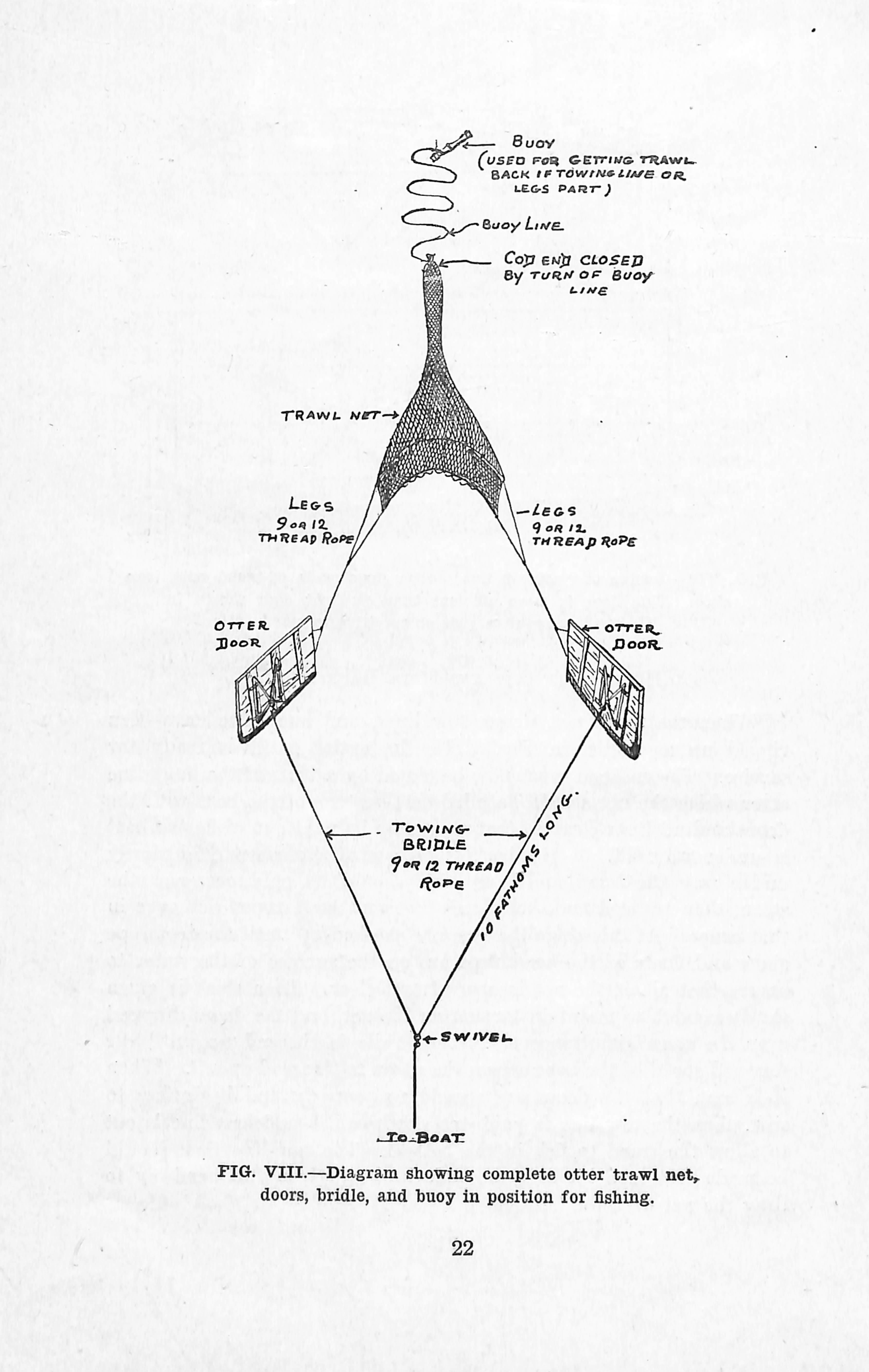
TH^wu ner-^á
i-Eos 9<>«/2. / thkbap RePe/.
ottbk. ^
\—/ees \ <ioRli. \\ THUEApUaVe
ToWlivsBRJP1.E f•'? /2 THKCAO/
■ OTTEH^í)ooit
g^-sw/veu
-j::e-BoAX
FIG. VIII.—Diagram showing complete otter trawl net, doors, bridle, and buoy in position for fishing.
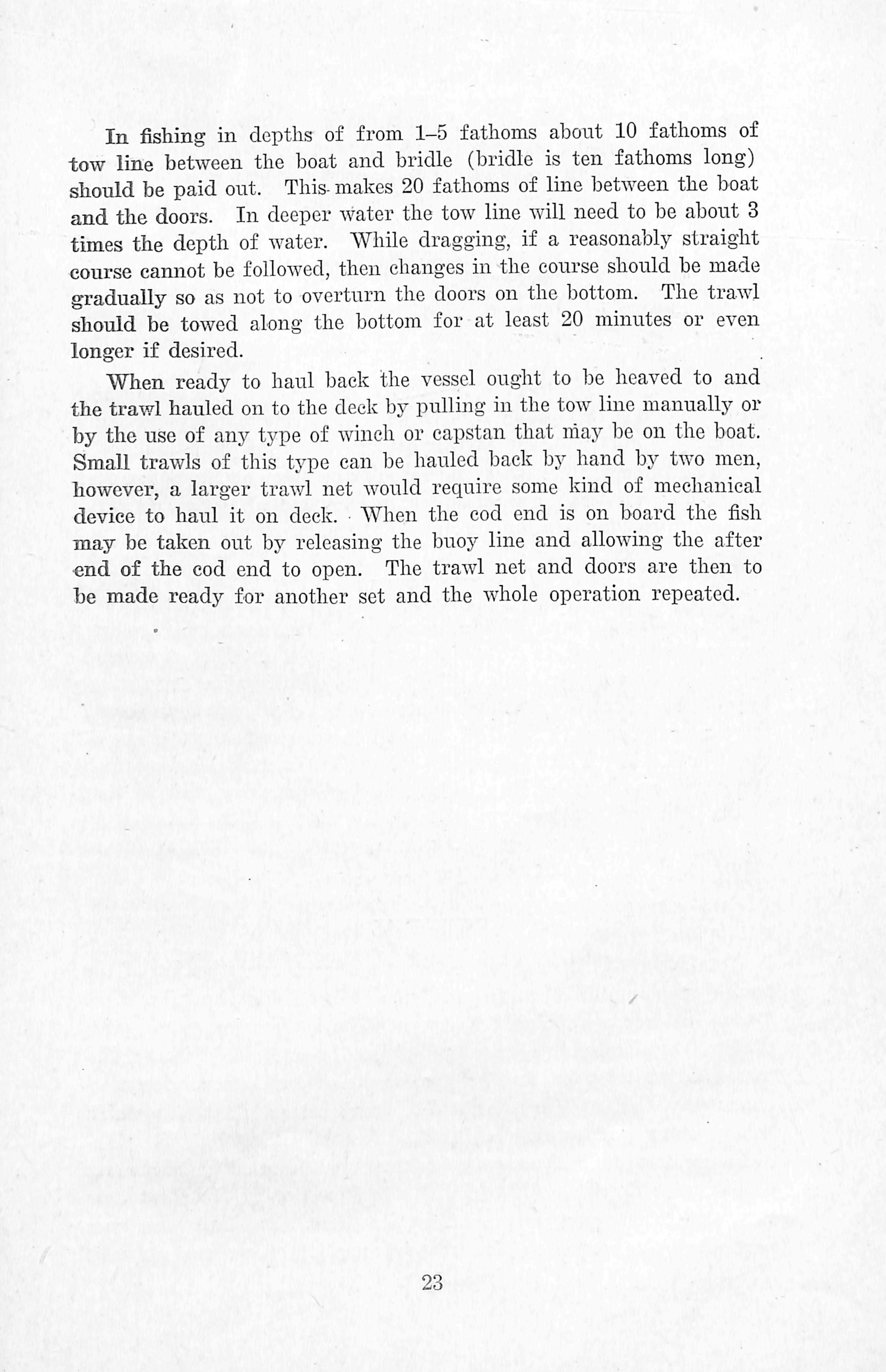
Tn fishing in depths of from 1-5 fathoms aboiit 10 fathoms of tow line between the boat and bridle (bridle is ten fathoms long) should be paid out. This- makes 20 fathoms of line between the boat and the doors. In deeper water the tow line will need to be abont 3 times the depth of water. While dragging, if a reasonably straight course cannot be followed, then changes in the conrse should be made gradually so as not to overturn the doors on the bottom. The trawl should be towed along the bottom for at least 20 minutes or even longer if desired.
When ready to haul back the vessel ought to be heaved to and the trawl hauled on to the deck by pnlling in the tow line manually or by the use of any type of winch or eapstan that may be on the boat. Small trawls of this tj^e can be hauled back by hand by two men, however, a larger trawl net would require some kind of mechanical device to haul it on deck. When the cod end is on board the fish may be taken out by releasing the buoy line and allowing the after ■end of the cod end to open. The trawl net and doors are then to be made ready for another set and the whole operation repeated.
Mr. Roger W. Harrison, Chief of the Teelinological Section of the División of Fishery Industries, U. S. FLsli and Wildlife Service visited the Fishery Eesearch Laboratory at Mayagüez. MTiile iii Puerto Rico he conferred with Messrs. Bonnet and Puneoehar and members of the Laboratory staff on general fishery matters and inade a three day survey of the varions fishing eenters of the Island. In addition to the Fishery Eesearch Laboratory at Mayagüez, Mr. Harrison suiiervises the work of laboratories located at College Park Maryland, Seattie, Washington, and Ketchikan, Alaska.

Mr. Andre Audant, Chief, Section of Entomology and Zooloo'v Service National de la Prodiiction Agrieole et de L'enseiguenient Rural Haití, reeently visited Puerto Rico. During his stay, inem61s of the laboratory staff acconipanied hiiii on several trips aboard le exp oiatoiy xes^el 17. B. Lewis and to varions fishing eenters of ^e Island. Mr. Félix Iñigo, Superintendent of the i\Iaricao Fish Hatchery vas host to Mr. Audant during a one-day visit to that place The information seeured froin the Puerto Rican fisheries bv ili Audant will be used as baek ground material in plaiinino' for a'u extensión of the marine fisheries of Haiti. °
D.r. Herbert H. Brovn, Director of Fi.sheries Investi^ation of the Development and Welfare in tbe British West Lidies, and Dr E P Thompson, newly appointed Fishery Officer in Jamaica, vere'..uests the División of Fislieries and Wildlife and the Fisherv Ee search Laboratory for the first tvo weeks of May. Severll cLer fireivTatte''" dies vere r the British West In- , 1 eie discussed. An unusual interest vas indicated in the amoiiot íhaf tbe'^fiT' i" cluring the short time naÍticÍar] 7 Thompson vas paiticularl, mterested ni obtaining informatioii on vet and dry-salt
methods for curing tropical mariue fishes and also in inforraatioii pertaining to the fresh water fishes that are beiiig introduced inte the inland waters of Puerto Eieo by tbe Marieao Fisb Hatcbery.

A report entitled "Praetices and Operating Costs of Puerto Rican Pisbermen" was released for distribution reeently by tbe Agrieultural Experiment Station of tbe University of Puerto Rico. Tbe data discussed in tbis report was obtained tbrougb a cooperative study conducted by tbe Agrieultural Experiment Station, Tbe Divi sión of Ornitbology and Pisciculture, and tbe Eisbery Researeb Laboratory. Persons desiring copies of tbis report sbould eommunicate witb tbe Director, Agricultura] Experiment Station, University of Puerto Rico, Río Piedras, Puerto Rico. Tbe report was publisbed as "Mimeograpb Report" No. 21, January, 1943.
An interesting article entitled "Boquerón Como Indice de lo que Puede Esperarse de la Industria Pesquera", by Rafael Sacarello, wbicb describes tbe progress of a newly establisbed fisbing firm at Boquerón, appeared in tbe Puerto Rico Ilustrado for tbe week of April 17, 1943.
Mr. Pedro Vergne Roig, Eisbery Economist wbo it studying under an Insular Government Fellowsbip at tbe University of Maryland for a Master's degree in Eisbery Economics, reports tbat bis studies are progressing satisfactorily and tbat be expects to return to Puerto Rico sbortly after graduation. Wbile on tbe Continent, Mr. Roig visited severa! of tbe more important fisbing centers including Gloucester, Mass., Boston, New York, and Reedville, Virginia.
Tbree students from tbe College of Agriculture and Mecbanic Arts at Mayagüez are currently engaged as Fellows in Eisbery Re seareb at tbe Laboratory at Mayagüez. Tbese students are Mrs. Carmen V. González Marini, and Messrs. Jacinto Eigarella and Ro sendo Arce Presten. Tbe students are receiving fundamental training in fishery researeb wbicb will prepare tbem to qualify for work in tbe fisberies of Puerto Rico.
As a result of tlie war, shark fiesh is being adcled to the Nation's Menú in the t'orm of shark steaks and wet and dry-salted producís. The delicate flavor of shark flesh is not unlike that of other fish and is proving to he very popular. Because of its excellent food qualities, the dry-salt product will undouhtedly find a place in the diet with other grades of dry-salt fish.
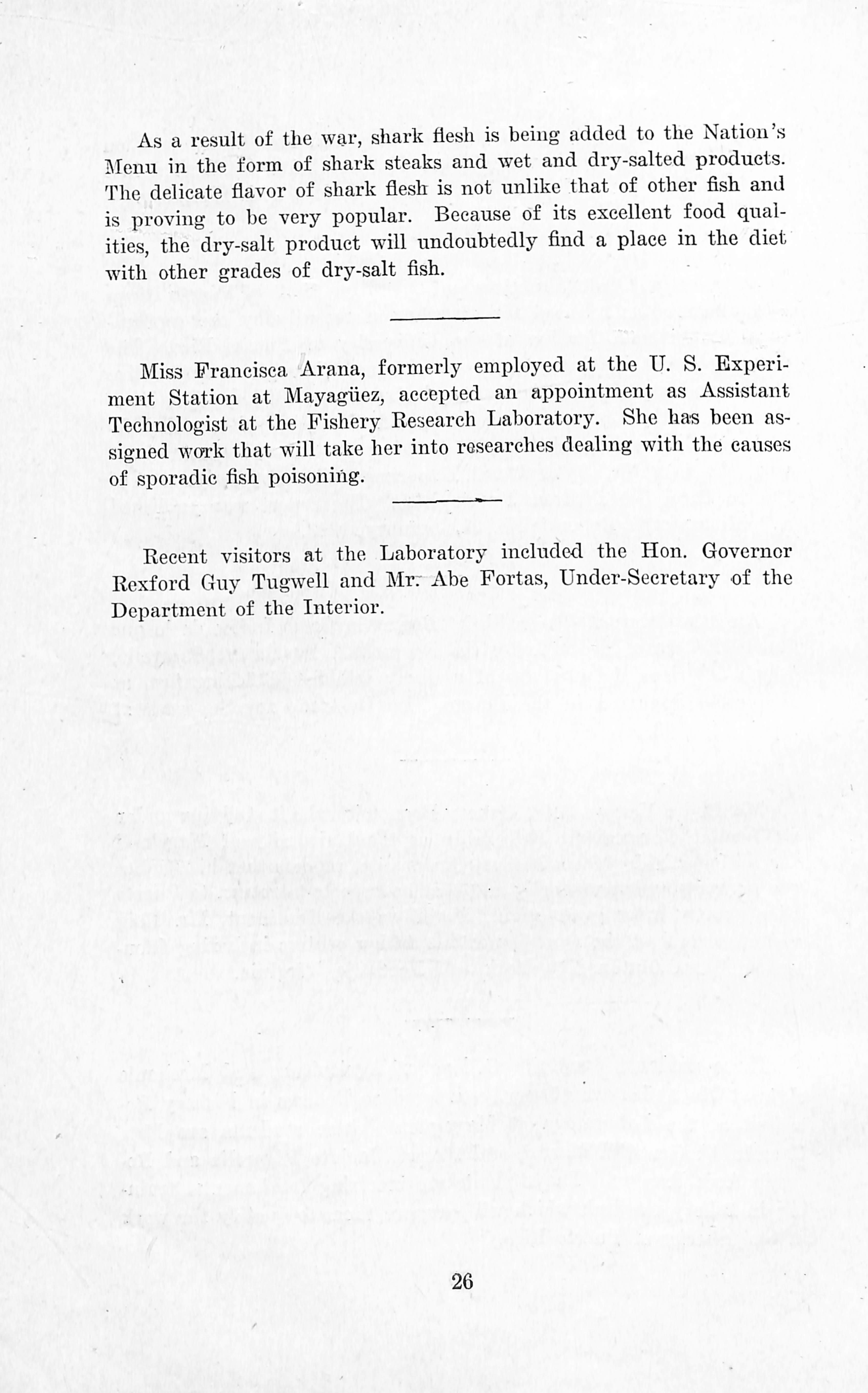
Miss Francisca Arana, formerly einployed at the U. S. Experiment Station at Mayagüez, accepted an appointment as Assistant Technologist at the Fishery Research Lahoratory. She has heen assigned work that will take her into researches dealing with the causes of sporadic fish poisoniñg.
Recent visitors at the Lahoratory included the Hon. Governor Rexford Guy Tugwell and Mr: Abe Fortas, Under-Secretary of the Department of the Interior.